
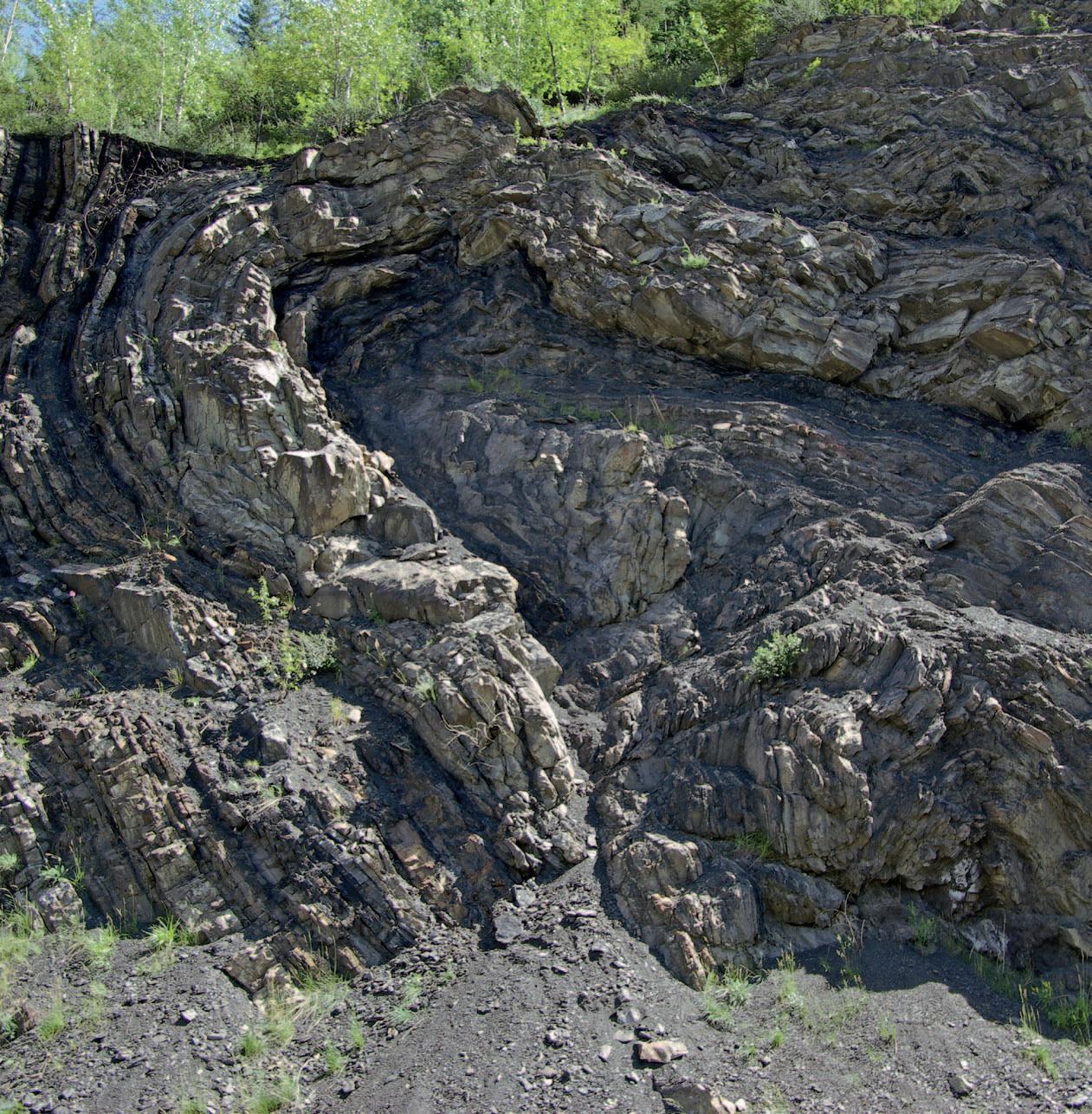

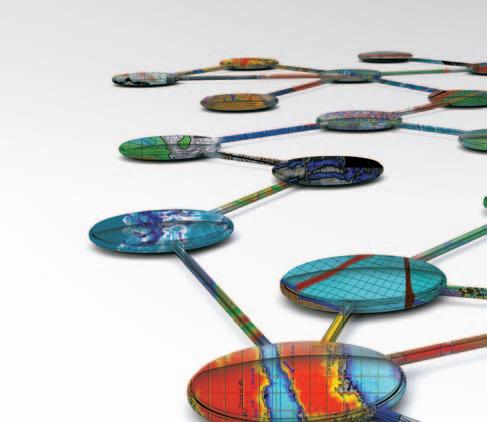

> GEOSCIENCE SOFTWARE
> CRITICAL INFORMATION
> CONNECTED WORKFLOWS

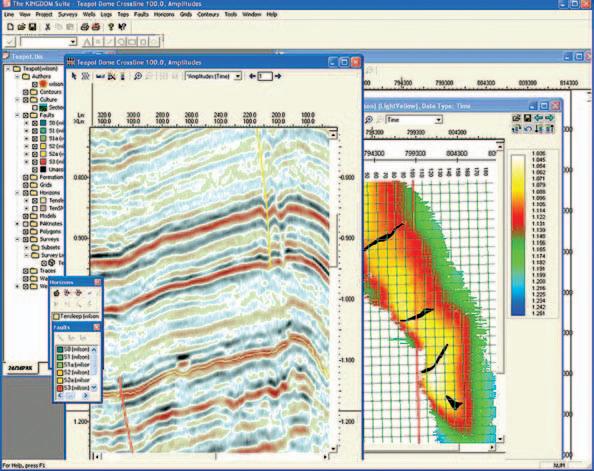
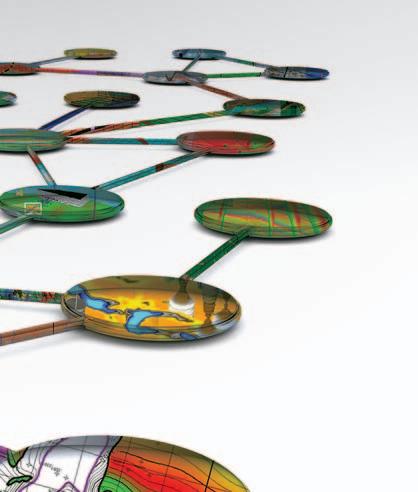








> GEOSCIENCE SOFTWARE
> CRITICAL INFORMATION
> CONNECTED WORKFLOWS






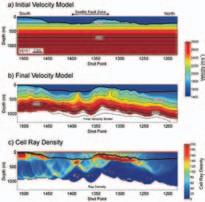


The IHS suite of geoscience software—which includes IHS Petra®, Kingdom®, LOGarc™ and GeoSyn™—is designed to seamlessly connect to the industry’s leading source of critical Oil & Gas information, eliminating the need to move data manually from source to source and project to project. With this powerful new combination, users can streamline data transfer, enhance database performance and simplify project sharing. The result? Workflows that connect like never before.
Connected workflows mean that IHS customers spend less time looking for data and more time looking for the next big opportunity. It’s just one of the many ways that IHS helps to advance the decisions that advance the Oil & Gas industry.
Find out more at IHS.com/geoscience

CSPG OFFICE
#110, 333 – 5th Avenue SW
Calgary, Alberta, Canada T2P 3B6
Tel: 403-264-5610
Web: www.cspg.org
Office hours: Monday to Friday, 8:30am to 4:00pm
Executive Director: Lis Bjeld
Tel: 403-513-1235, Email: lis.bjeld@cspg.org
Member Services:
Tel: 403-264-5610, Email: membership@cspg.org
Publications and Website: Emma MacPherson
Email: emma.macpherson@cspg.org, Tel: 403-513-1230
Programs Development: Aileen Lozie
Tel: 403-513-1227, Email: aileen.lozie@cspg.org
Database Administrator and Accounting: Kasandra Amaro
Maternity leave until January 2014
Corporate Sponsorship: Lis Bjeld
Tel: 403-513-1235, Email: lis.bjeld@cspg.org
Controller: Eric Tang
Tel: 403-513-1232, Email: eric.tang@cspg.org
Please submit RESERVOIR articles to the CSPG office. Submission deadline is the 23rd day of the month, two months prior to issue date. (e.g., January 23 for the March issue).
To publish an article, the CSPG requires digital copies of the document. Text should be in Microsoft Word format and illustrations should be in TIFF format at 300 dpi., at final size. For additional information on manuscript preparation, refer to the Guidelines for Authors published in the CSPG Bulletin or contact the editor.
Technical Editors
Ben McKenzie Colin Yeo (Assistant Tech. Editor) Tarheel Exploration Encana Corporation
Tel: 403-277-4496 Tel: 403-645-7724
Email: bjmck@live.com Email: colin.yeo@encana.com
Coordinating Editor
Emma MacPherson, Publications Coordinator, CSPG Tel: 403-513-1230, emma.macpherson@cspg.org,
ADVERTISING
Advertising inquiries should be directed to Emma MacPherson, Tel: 403-513-1230 email: emma.macpherson@cspg.org. The deadline to reserve advertising space is the 23rd day of the month, two months prior to issue date.

Heavily contorted Jura-Cretaceous
Group sandstones and siltstones


They can copy us. They just can’t be us. If imitation is the sincerest form of flattery, we’re one flattered group. Drawing on a quarter century of oil and gas experience, geoLOGIC continues to be the market leader in data, software solutions and support. And while we lead the way, our competitors desperately create parity products, sometimes years after us. For details on how geoLOGIC leads the way, visit www.geoLOGIC.com/leader
Leading the way with customer-driven data, integrated software and services for your upstream decision-making needs.
geoSCOUT | gDC | petroCUBE at www.geoLOGIC.com














President
Paul MacKay • Shale Petroleum Ltd. paul.mackay@shalepetroleum.com Tel: 403.457.3930
Vice President
Dale Leckie • Nexen Inc. daleleckie@nexeninc.com Tel: 403.613.0458
Past President
Robin Mann • AJM Deloitte rcmann@deloitte.ca Tel: 403.648.3210
Finance director
Samantha Etherington • CNRL samantha.etherington@cnrl.com Tel: 403.386.6459
assistant Finance director
Gord Stabb • Durando Resources Corp. gstabb@durando.ca Tel: 403.819.8778
Program director
Dave Russum • AJM Deloitte drussum@deloitte.ca Tel: 403.648.3228
assistant Program director
Alexis Anastas • Nexen Inc. alexis_anastas@nexeninc.com Tel: 403.699.4965
serVices director
Mike Seifert • Canadian Discovery mseifert@canadiandiscovery.com Tel: 403.269.3644
assistant serVices director
Weishen Ren • Statoil Canada Ltd. wren@statoil.com Tel: 403.724.0325
communications director
Curtis Evans • ERCB curtis.evans@ercb.ca Tel: 403.297.8386
assistant communications director
Riona Freeman • Harvest Operations Corp. riona.freeman@harvestenergy.ca Tel: 403.233.6624
outreach director
Dawn Hodgins • Imperial Oil Resources dawn.hodgins@exxonmobil.com Tel: 403.232.5931
assistant outreach director
Andrew Fox • MEG Energy Corp. andrew.fox@megenergy.com Tel: 403.770.5345
executiVe director
Lis Bjeld • CSPG lis.bjeld@cspg.org Tel: 403.513.1235
A message from 2012 Finance Director, Andrea Hood
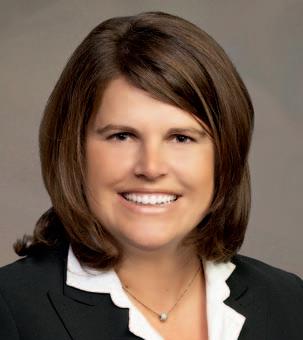
The fortunes of our society are inevitably linked to the well-being of our industry. 2012 was a challenging and turbulent year for the industry that sustains the CSPG. While oil producers did relatively well and the health of this component of the industry was reflected in soaring demand for office space in downtown Calgary, their fortunes were tempered by the inability to receive world price for their product due to the oil glut in the Mid-West. Our gas producers experienced a particularly difficult year as prices stubbornly remained below economic levels and the rising cost of new technology has made it more difficult for smaller companies to raise enough capital to spread the risk of additional wells. In consequence, during the CSPG 2012 fiscal year just over 19,000 wells were licensed in western Canada compared to over 20,000 wells during the previous year.
Mirroring our industry, the CSPG saw a decrease in revenue from $2,916,903 in 2011 to $2,732,948 (6%), while total costs were 3% less than in 2011. This combination of factors produced a net profit of $307,512 at the end of our fiscal year 2012 compared to $434,921 in 2011, a drop of 29%.
These results are still very positive and will allow us to provide even more services to our members as well as supporting new initiatives. Additional office staff will be required to support these initiatives effectively, in an effort to continue to grow the society’s overall presence.
The CSPG technical programs net revenue in our fiscal year 2012 was $257,076 compared to $261,914 in 2011. One of the primary reasons for maintaining this number so close to 2011’s numbers was the successful Gussow conference in Banff. This conference alone resulted in a net profit of over $100,000 and was attended by over 110 delegates. We had 22 speakers and a very strong technical program. There was no Gussow conference during the prior fiscal period, but the CSPG was responsible for the Core Conference as part of the AAPG ICE 2010.
Our technical luncheons are continuing to see good attendance. Due to an increase in costs by the Convention centre and additional advertising costs we saw a 16% drop in net profits for the luncheon series in 2012 over 2011. The CSPG feels strongly about not passing this cost on to our members and have kept the lunch ticket fees unchanged during this past fiscal period.
This year’s CSPG’s Joint Annual Convention ‘VISION’ was operated by the CSEG on behalf of the CSPG and the CWLS. The CSPG’s profit share from `VISION’ was $457,488, an increase of 13% from the previous year’s total of $403,706. The increase is attributed to an increase in delegate fees, and additional revenue from sales of exhibit floor space that compensated for the reduced attendance. Cost reductions in many areas, primarily on food and beverage, also helped improve the bottom line. ‘VISION’ did see a 10% decrease in ‘full’ delegates that registered and attended the convention – in 2012 the full delegate number was 2,009 compared to 2,225 in the previous year. This was likely due to some of the turbulences we saw throughout the year. We are very encouraged to seen that the Student Delegate attendance increased from 155 to 2011 to 280 in 2012 (80%).
Please see graphs for Revenues and Expenses (page 7) for more detail.
The reason for the increase in Expenses for Operations from 2011 to 2012 is primarily due to the office move to our new location and related expenses.
We also invested in transitioning our previous Website to a new, more user-friendly technology platform that now allows us to upload daily news content to provide members with up-to-date information.
The graph at the bottom of page 7 provides more detail on our Net Profit.
We did see a change in membership compared (Continued on page 7...)

DiAM o ND
Geologic Systems Ltd.
Pl ATi N u M
Apega
Cenovus Energy
ConocoPhilips Canada
CNOOCO -Neven
GolD
Devon Energy Corp.
Encana Corporation
Imperial Oil Ltd.
Shell Canada Limited
Silver
Athabasca Oil Sands Corporation
CSEG Foundation
CSPG Educational Trust Fund
EOG Resources
IHS
LED Signs
Roke Technologies Ltd.
TAQA North Ltd.
Bro N ze
AGAT Laboratories
CNRL
Husky Energy Inc.
Loring Tarcore
Poggenpohl
RIGSAT Communications
RPS Energy
Schlumberger Canada Limited
Sensor Geophysical Ltd.
Suncor Energy
Talisman Energy
As of December 2012
A Special Thanks to Geologic Systems Ltd.,
C SPG ’s Top Sponsor of the Month
from page 5)
to the prior year. Our regular membership decreased by 6% from 2,649 in 2011 to 2,490 in 2012, although we did see a noticeable increase in our associated members of 9% over from 372 in 2011 to 406 in 2012. The Emeritus and Honorary members were almost unchanged, which resulted in a total current member count of 3,065. In addition, we now have over 300 Student Members. This category has been increasing year after year.
As in previous years we held the Annual Squash tournament, the Classic and Mixed Golf Tournaments, the Road Race, Young Professional events, The Long-time Members
Reception, Awards Gala as well as the Past Presidents Dinner. All events were well attended and always give members the opportunity to connect and have fun.
In closing I would like to thank our sponsors for their support and continuing sponsorships in 2012. We hope that you will support the CSPG for many years to come.
I would like to also thank the office staff and Lis Bjeld, Executive Director, for all their hard work through 2012. Only with all their help is it possible for us to achieve our goals for the years to come. Thank you!
SPEAKER
W.C. ‘ r usty’ r iese
AAPG Distinguished Lecturer Retired
Houston, Texas
Funded by the AAPG Foundation
11:30 am
t hursday, January 10, 2013
c algary, te L us c onvention c entre e xhibit h all e , n orth Building c algary, a lberta

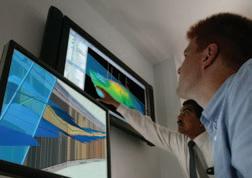
NExT oil and gas training and career development instructs more than 10,000 E&P professionals every year.
With hands-on mentoring and coaching, at a Schlumberger training facility or on the job, NExT training can help you expand your technical expertise.
To view our full list of courses, and to enroll, visit www.NExTtraining.net
Featured course: Advanced Seismic Interpretation 3–7 June 2013 Calgary, Alberta

Please note: the cut-off date for ticket sales is 1:00 pm, monday, January 7, 2013. csPg member ticket Price: $45.00 + gst. nonmember ticket Price: $47.50 + gst.
Each CSPG Technical Luncheon is 1 APEGA PDH credit. Tickets may be purchased online at www.cspg.org.
Increasing global demand for energy has forced societies the world over to look for and use ever more diverse and expensive forms of energy to fuel their economies. Oil is a key part of this energy supply, particularly in the arena of transportation fuels. The corporations that supply energy have been pressed into increasingly challenging environments to meet public and governmental demands for inexpensive energy. Unfortunately, as we are reminded by the Gulf of Mexico Deepwater Horizon incident, accidents can happen, the environment can be damaged, and people can lose their lives when we operate at the leading edges of technology.
When accidents occur, our responses typically tend to blame individuals, corporations, or regulators, rather than the public whose demand for cheap, readily available energy forces exploration in new, more challenging frontiers. Public opinions on this subject are shaped by a combination of self-education, fulminating politicians, and aggressive, sensationalist journalists.
Exploring more than societal interests at a national level puts our pursuit of inexpensive energy into context. This context pits the competing interests of developing countries, which demand ever increasing shares of the world’s resources, against broader,

trans-national interests groups that are worried continued dependence on energydense fossil fuels may cause runaway global warming and climate changes that may, in turn, destroy the earth’s ecosystems.
Ultimate responsibilities for oil spills lie within this mix of competing demands and expectations – a mix far more complicated than most people are aware of or are willing to consider. All of us who consume energy have an ethical obligation to educate ourselves, and those around us, on the consequences of our demands for energy and for the environment.
bIOGRAPH y
Dr. W.C. “Rusty” Riese is a geoscientist based in Houston, Texas. He is widely experienced having worked in both minerals and petroleum as a geologist, geochemist, and manager during more than 39 years in industry. He participated in the National Petroleum Council evaluation of natural gas supply and demand for North America that was conducted at the request of the Secretary of Energy and in the more recent analysis of global supply and demand requested by the same agency. He is currently a member of the American Association of Petroleum Geologists Committee on Resource Evaluations, and a member of the House of Delegates.
Rusty has written extensively and lectured on various topics in economic geology including biogeochemistry, isotope geochemistry, uranium ore deposits, sequence stratigraphy, and coalbed methane petroleum systems; and he holds numerous domestic and international patents. He has more than thirty years of teaching experience including twenty-five years at Rice University where he developed the curricula in petroleum geology and in industry risk and economic evaluation. He is currently an Adjunct Professor at Rice University, the Colorado State University, and the University of New Mexico, where he sits on the Caswell Silver Endowment advisory board. He is a fellow in the Geological Society of America and the Society of Economic Geologists, and a member of the American Association of Petroleum Geologists and several other professional organizations.
He earned his Ph.D. from the University of New Mexico in 1980; his M.S. in geology from the same university in 1977; and his B.S. in geology from the New Mexico Institute of Mining and Technology in 1973. He is a Certified Professional Geologist and a Certified Petroleum Geologist, and is a Licensed and Registered Geologist in the states of Texas and South Carolina respectively.
SPEAKER
Art Saller
AAPG Distinguished Lecturer
11:30 am
tuesday, January 22, 2013 c algary, te L us c onvention c entre m acleod h all c / d, s outh Building c algary, a lberta
Please note: the cut-off date for ticket sales is 1:00 pm, Wednesday, January 16, 2013. csPg member ticket Price: $45.00 + gst. non-member ticket Price: $47.50 + gst
Each CSPG Technical Luncheon is 1 APEGA PDH credit. Tickets may be purchased online at www.cspg.org.
AbSTRACT
The diagenetic evolution of porosity and permeability in carbonates is complex and involves a number of independent factors. Carbonate sediments start with 40-80% porosity and generally lose porosity with time and burial (Schmoker and Halley, 1982); however, there are many factors that cause higher and lower porosity in carbonates of the same age and burial depth.
Alteration of carbonate sediments during shallow burial is common and includes

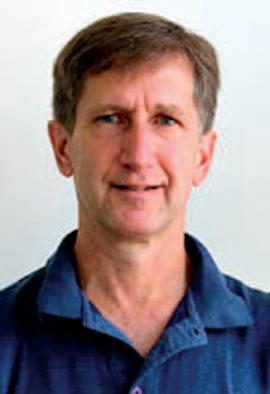
diagenesis in seawater shortly after deposition, freshwater diagenesis during subaerial exposure, and dolomitization in hypersaline waters. Marine (seawater) diagenesis varies with depth and carbonate saturation as is shown on Enewetak Atoll. Aragonite and Mg-calcite cementation dominate in shallow seawater; however, aragonite is dissolved and radiaxial calcite precipitates in moderately deep seawater. In even deeper seawater, calcite dissolves and dolomite precipitates. Freshwater (meteoric) diagenesis and dolomitization commonly rearrange and decrease porosity, but they also impart strength to the rock that reduces porosity loss during deeper burial.
Pennsylvanian limestones in west Texas show that prolonged subaerial exposure progressively decreases matrix porosity but increases conduit porosity (fractures and vugs), and hence, formation permeability. Reflux dolomitization is commonly associated with carbonates in arid climates like the Permian of the Permian Basin. The porosity and permeability of reflux
Webcasts sponsored by

dolomites varies according to position in the dolomitizing system with less porosity and permeability in proximal parts of the dolomitizing system. Dolomitization decreases rate of porosity loss with burial (Schmoker and Halley, 1982) allowing some porous dolomite reservoirs like the Smackover of south Alabama at depths of 16,000-18,000 feet. Deep burial dissolution increasing porosity is the exception, rather than the rule. In summary, unlike quartzose sandstones, a complex array of diagenetic factors generally affects the ultimate porosity, permeability, and production of carbonate reservoirs.
bIOGRAPH y
Art Saller is a stratigrapher and exploration geologist working for Cobalt International Energy in Houston, Texas. He received his B.S. degree from the University of Kansas, M.S. degree from Stanford University, and Ph.D. from Louisiana State University (1984). Art worked for Cities Service/Occidental, Unocal, and Chevron prior to joining Cobalt in 2012.
During 28 years in the petroleum industry, he has done research and provided stratigraphic support for exploration and production projects in west Texas, Canada, Angola, Indonesia, and many other locations.
Art has published numerous papers on carbonate sedimentology and deep-water siliciclastic systems as well as help edit books. In 2007, he was part of an exploration team that was given Chevron’s Chairman’s Award for oil discoveries in offshore Angola.
Art has helped run field trips to the Caicos Platform (Bahamas), Belize, and the Permian Basin (USA) for Cities Service/Occidental, Unocal, Chevron, university geology groups, and the Nautilus Training Consortium for more than 25 years. He is a member of AAPG and has also taught short courses for AAPG.
For Engineers, Geologists, Geophysicists, and Technicians
Practical Quantitative Log Analysis: 15 – 17 Apr 2013
Analysis of Unconventional Reservoirs: 18 Apr 2013 Analysis of Rock Mechanical Properties: 19 Apr 2013
Details and Registration at: www.spec2000.net/00-coursedates.htm
In-House and Multi-Media Narrated Self-Study Courses Also Available
===
Reservoir Geomodeling Reservoir Simulation Integrated Study
Julee Lee (403) 554-3957, Helen Cao (403) 968-6268, Gary Selby (403) 818-1594 jlee@petrosteer com, hcao@petrosteer com, gselby@petrosteer com
Instructor: E. R. (Ross) Crain. P.Eng. 1-403-845-2527 ross@spec2000.net === – 50 Years Worldwide Experience – Analysis, Training, Mentoring, Forensic Reviews –
SPEAKER
Hans Machel11:30 am tuesday, February 5, 2013 c algary, te L us c onvention c entre e xhibit h all e , n orth Building c algary, a lberta
Please note: the cut-off date for ticket sales is 1:00 pm, thursday, January 31, 2013. csPg member ticket Price: $45.00 + gst. non-member ticket Price: $47.50 + gst.
Each CSPG Technical Luncheon is 1 APEGA PDH credit. Tickets may be purchased online at www.cspg.org.
AbSTRACT
Barbados is located at 13°10’ north latitude, 59°35’ west longitude, and is about 32
lu NCH eoNS Su BJeCT
To CHANGe.
Please Check www.cspg.org for the most up to date information.


x 23 km in size. Overlying tectonically deformed siliciclastic sediments, about 80% of the surface of the island is made up of Quaternary carbonates with ages approximately 800,000 years to recent. These carbonates are a few meters to about 120 m in thickness and form a series of terraces, which were deposited in response to an interplay of tectonic uplift and eustatic sea level changes, with tectonic uplift ranging episodically from ~7 to 440m per 100,000 years over the past 800,000 years.
The Pleistocene carbonates, and even some underlying Miocene chalks, are extensively overprinted by epigene (top-down) and hypogene (bottom-up) karst processes. Epigene karst features include various types of caves, solution valleys, and sinkholes. Flank margin caves are the most common cave type. Sinkhole density is high, with an average of five sinkholes per square km. However, some areas have a much higher density while others are almost devoid of sinkholes. Sinkholes range in diameter from about 10m to 120m and are up to about 15m deep. Another striking morphological karst feature is a network of valleys, locally referred to as gullies. Their origin is problematic and much debated. Most gullies have caves along at least a part of their paths, commonly decorated with flowstone or other speleothems.
A number of lessons learnt from the karst in Barbados can be applied to the Devonian Grosmont reservoir in Alberta, despite the vast differences in age and size. For example, numerous sinkholes identified in seismic
images can be interpreted as epigene karst features that developed rapidly on one or several former land surfaces. Drainage patterns akin to the gullies of Barbados can be expected in the Grosmont as well, but not as deep or as densely spaced, and with different orientations. The Grosmont may contain a few stream caves and many more flank margin caves, while the latter should not be as frequent as in Barbados but may be considerably larger.
Integrating these aspects with the known geologic history of Alberta, it appears that the Grosmont platform was karstified in at least two major epigene episodes, and perhaps as many as four. The first major episode for which there is tangible evidence was a ‘warm epigene karstification’ during the Jurassic –Cretaceous, for which Barbados provides a useful analog. The second episode was/is a ‘cold epigene karstification’ that started sometime in the Cenozoic and is continuing to this day. The present repertoire of karst features probably is a composite of these two epigene karstification episodes. In addition, circumstantial evidence suggests that epigene karst gives way to a deep hypogene karst in the downdip part of the platform. The latter likely has different characteristics, i.e., most notably a maze system of passages rather than a stream system overlain by sinkholes. At present the hypogene karst system in the Grosmont is virtually unexplored.
SPEAKER
r ichard K. StoneburnerAAPG
Distinguished Lecturer11:30 am Wednesday, February 20, 2013 c algary, te L us c onvention c entre m acleod h all c / d, s outh Building c algary, a lberta
Please note: the cut-off date for ticket sales is 1:00 pm, Wednesday, February 13, 2013. csPg member ticket Price: $45.00 + gst. non-member ticket Price: $47.50 + gst.
Each CSPG Technical Luncheon is 1 APEGA PDH credit. Tickets may be purchased online at www. cspg.org.
AbSTRACT
The discovery of commercial oil and gas production from shale or mudstone reservoirs has dramatically changed how we explore for and develop oil and gas accumulations. In conventional exploration, appraisal, and development there is a fairly standard and accepted application of processes and technologies. However, the processes and technologies that are employed in the exploration, appraisal, and development of mudstone reservoirs are significantly different, and they are often employed for different reasons and at different stages of the cycle.
Prospect identification is always the initial phase of any exploration project. In most cases in the conventional world this is a result of the interpretation of seismic data, either 2D and/or 3D, in order to identify the areal extent of the prospect, which would typically be on the order of a few hundred acres or in some instances a few thousand acres. However, in the unconventional world the identification is done at a basin level and is not typically supported by seismic, but rather by detailed analysis of a few key wells and their associated petrophysical attributes. Once those attributes are deemed to have the potential of supporting a commercially productive mudstone reservoir, then the utilization of seismic might be

employed to help define the boundaries of the reservoir. However, that would typically be the exception as the reservoir boundaries are generally defined by the configuration of the basin, which is generally fairly well understood and can encompass a million acres or more.
Once the prospect has been identified, the evaluation processes during the exploratory drilling phase are dramatically different. During conventional exploration the validation of the presence, or lack, of hydrocarbons is largely done by the acquisition and interpretation of data from open-hole wire-line logs. While cores, either whole or sidewall, will often be taken, they are typically acquired not to validate the productivity of the reservoir but rather to supplement the open-hole log data. In unconventional exploration, the opposite is the case. While the open-hole logs are extremely important once the discovery is made to calibrate the reservoir, the most critical data around the validation of the quality of the reservoir is the detailed analysis of the rock acquired from whole core. While some of the attributes that are measured from the mudstone core are common to conventional exploration, there are many more measurements that are taken on mudstone reservoirs that are totally unique to this type of reservoir.
As the prospect moves into appraisal and development mode, there are also unique processes and technologies in the unconventional world that are used to more fully understand the reservoir. The most important of those is the calibration, through the use of specific algorithms, of the data acquired from the whole-core data to the open-hole data that is being acquired from the appraisal and development drilling. Because the cost and time necessary to acquire an extensive collection of wholecore data can be prohibitive, there will be a limited number of wells from which whole

core is taken in any given field. Therefore, it is critical to be able to calibrate the various measurements from the whole core to the open-hole log data that will be available on many more wells. This is also the point during which 3D seismic would be acquired as opposed to the acquisition of that type of data during the identification process. In unconventional development, the primary benefit of the 3D seismic data is not to identify where you want to drill, but where you don’t want to drill. Specifically, the horizontal lateral is placed to minimize the effect of faulting on the lateral.
Throughout the entire period of field appraisal and development, the practice of geosteering is critical to the economic success of the field. Since virtually all of the unconventional development is done with the application of horizontal drilling, it is critically important that the drill bit maintains its position within the highest quality reservoir while the lateral is being drilled. Since the drilling operations are performed around the clock, and unexpected changes in dip or the presence of faults can cause the bit to rapidly change its relative stratigraphic position, a Gamma Ray tool is incorporated into the bottom-hole drilling assembly in order to provide continuous measured depth Gamma Ray log data, which is then converted to a true vertical depth (TVD) log using software designed specifically for this process. This TVD log data is subsequently correlated with nearby well control to determine where the lateral is positioned stratigraphically at all times during the drilling operation. When the bit has been interpreted to be out of the desired stratigraphic section, or target window, it is the responsibility of the geosteerer to collaborate with the drilling organization to make the necessary changes to get the bit back into the target window.
bIOGRAPH y
Richard Stoneburner is President North America Shale Production Division for BHP Billiton Petroleum. Prior to joining BHP Billiton, Dick was President and Chief Operating Officer for Petrohawk Energy Corporation and was responsible for all upstream operations.
Dick’s earlier career positions include Vice President-Exploration of 3TEC Energy Corporation until its merger with Plains Exploration & Production Company and working as a geologist for a number of Exploration and Producing companies including Hugoton Energy Corporation, Stoneburner Exploration, and Texas Oil and Gas.
Dick has more than 35 years of experience in the energy business and has a Bachelor of Science degree in Geological Sciences from The University of Texas at Austin and a Masters of Science degree in Geology from Wichita State University.
SPEAKERS
Jim Pullishy and Aline l abrie
SPEAKER
Mary e llen Havlik
Regional Advisor (West Africa), Veracity Worldwide
12:00 Noon
Wednesday January 9th, 2013 Nexen Plus 15 Conference Centre Nexen Annex Building 7th Ave. & 7th St. SW Calgary, Alberta
Ab STRACT
Background of the rise and fall of kidnapping in Nigeria (2005-2008) with a brief overview of Canadian consular services and travel advisories that affect Canadians traveling to Nigeria and other foreign countries.
An overview of the Federal Government’s Amnesty Program that resulted in a drop in kidnappings and a rise in oil production followed by a current snapshot of security across the West African region and what’s next for new oil producers in the region such as Ghana.
bIOGRAPH y
Mary e llen Havlik
After 20 years with the RCMP serving in Saskatchewan, Ontario, and the National Capital Region, I was offered an opportunity to work overseas in Nigeria with the Canadian Foreign Service. Having previously participated in a cross-cultural exchange in Togo (1986) and having travelled extensively across West Africa, the opportunity to return to Africa was accepted without hesitation. My diplomatic work started in January 2005 when I was posted to Abuja, Nigeria as the Counselor, Management and Security as well as the Consular Affairs officer. I oversaw the office operations in Abuja, Lagos, and Port Harcourt and was often called to other states within the country as part of Consular duties to aid Canadians in distress. During this period in Nigeria and, more specifically, in the Niger Delta, the IOCs were challenged with over 500 kidnappings, the majority of which were from the ABC nations, i.e., Americans, Brits, and Canadians. I spent a vast majority of my service in the Niger Delta assisting with hostages and conducting debriefings, work for which I was awarded a special commendation from the United States Government.
My diplomatic service continued until December 2008 when I was asked to return to the Mounted Police in Ottawa. At that time, I took a leave of absence and remained in the Niger Delta region volunteering on a school project with the Daniel Igali Foundation. (Daniel, a dual national Nigerian-Canadian won Gold for Canada at the 2000 Olympic Games in wrestling.) In addition to this volunteer work, I worked closely with the Bayelsa State Government helping to develop a sustainable development strategy for the
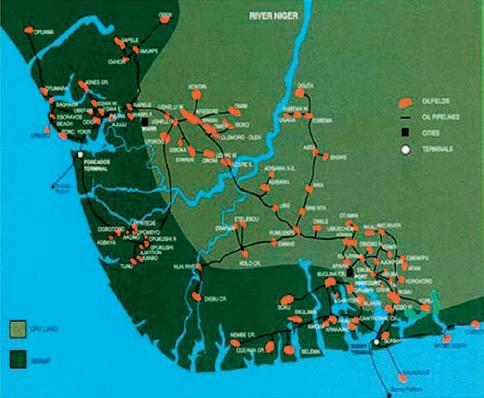
Sponsored by
State. I was often called upon by American and Canadian companies during this period to provide security and logistics support for visits to the volatile Niger Delta region.
I resigned from the RCMP in February 2010 and started a one-year contract with the United Nations Department of Safety and Security and was posted to the newly created Special Information Operations Centre (SIOC) in N’Djamena, Chad. Earlier this year, I returned to Nigeria where I am now the Regional Advisor (West Africa) for Veracity Worldwide, a NY-based due-diligence company. In this role, I conduct verification exercises for companies that are interested in doing business in West Africa. I continue to provide security and logistical support to individuals and businesses that wish to visit the region to explore business opportunities across a number of sectors and I assist the Nigerian Federal Government as well as several State Governments with building bridges to Canadian Federal Government partners and individual businesses for the purpose of development.
There is no charge. Please bring your lunch. The facilities for the talk are provided complimentary of Nexen, coffee by IHS, and refreshments by Geochemtech Inc. The speakers are provided with gifts by Drilling Information and Quad Operations. For further information or if you would like to give a talk, please contact Bob Potter at (403) 863-9738 or ropotter@geochemtech.com or Trent Rehill at (403) 606-6717 or trehill@kulczykoil. ca. Or visit our new Face Book page (“CSPG International Division”).
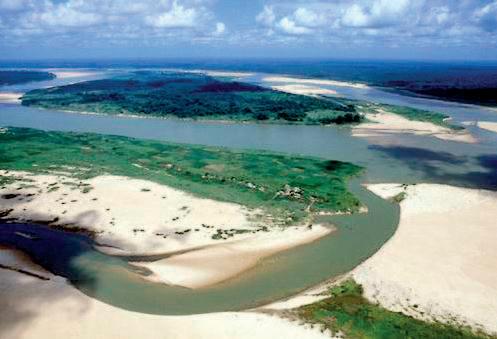
A
molecule’s eye view of reservoir continuityfaults: Barriers and baffles assessed geochemically
SPEAKERS
Dave r obertson, Ph.D.; Barry Bennett, Ph.D.; Steve l arter, Ph.D., F r S; Norka Marcano, Ph.D.; l loyd Snowdon, Ph.D.; Gushor Inc.
12:00 Noon
Thursday, January 10, 2013 Conference Centre r oom A, +30 level, Western Canadian Place (Husky e nergy), 707-8th Avenue S.W. Calgary, Alberta
SPEAKER
Ashton e mbry
Geological Survey of Canada
12:00 Noon
Thursday, January 17th, 2013 ConocoPhillips Auditorium, Gulf Canada Square, 401 – 9th Ave. S.W. Calgary, Alberta
AbSTRACT
The Arctic Ocean is comprised of two separate ocean basins, the Eurasia Basin and Amerasia Basin, which are separated from each other by a narrow strip of continental crust, the Lomonosov Ridge. The origin of the Eurasia Basin is not in dispute and it represents a continuation of the North Atlantic Ocean. A spreading ridge bisects the basin and well-defined magnetic anomalies indicate that seafloor spreading began in the Eocene and continues today.
The origin of the Amerasia Basin has been hotly debated since the acceptance of plate tectonics in the mid 1960s. The basin is triangular in shape and contains two positive features. The Alpha-Mendeleev Ridge, interpreted as a huge, intra-ocean,
magmatic edifice, stretches across the basin from Ellesmere Island, Canada to the East Siberian Sea of Russia. It subdivides the Amerasia Basin into the Canada Basin to the south and the Makarov Basin to the north. A rectangular micro-continent, the Chukchi Borderland, projects into the Canada Basin adjacent to the Chukchi Sea.
A lack of a well-defined spreading centre with associated magnetic anomalies has allowed numerous models for the opening of the Amerasia Basin to be put forward. The available geological data from the surrounding land areas and geophysical data from the basin itself strongly favour the model that the basin opened by the counterclockwise rotation of northern Alaska and adjacent Chukotka (Arctic Alaska-Chukotka microplate) away from the Canadian Arctic Archipelago. The most persuasive evidence that supports this model includes:
1. Match of Devonian tectonic zones
2. Match of Sverdrup Basin and Hanna Trough Axes
3. Match of erosional edges of Carboniferous, Permian, Early Triassic, and Early Jurassic strata
4. Match of Early Mesozoic facies belts
5. Match of Kuparuk paleomagnetic pole with NA pole
6. The identification of an extinct spreading ridge (gravity low) with possible fan-shaped, magnetic anomalies
The timing of the rift and drift phases for the opening of the basin are also under debate. The start of rifting appears to be either near
Sponsored by
DIVISION I NFORMATION:
Structural Division talks are monthly and cover a diversity of structural themes. Our Structural Division sponsors are HEF Petrophysical and Husky Energy. All are welcome and no registration is required. For additional information, to be placed on the Division e-mail list or to present a talk, please contact Darcie Greggs, Darcie.Greggs@huskyenergy. com.
Sponsored by
base Rhaetian (latest Triassic) or near base Bajocian (early Middle Jurassic). The near base Bajocian interpretation is presently favoured because that is the age of the oldest normal faults that parallel the margins of the Amerasia Basin. Furthermore, a major change in detrital zircon populations in sandstones derived from Crockerland, a small continental area that lies north of the Canadian Arctic Archipelago, occurred in early Bajocian. This zircon change is best explained by the start of rifting at that time and a dramatic transformation in the drainage area on Crockerland.
Ashton Embry did his graduate studies at the University of Calgary and worked for four of the “seven sisters” in the late '60s and '70s. For the last 35 years he has worked with the Geological Survey of Canada as a regional stratigrapher responsible for the Mesozoic successions of the Arctic Islands. As part of his Arctic work, he has pondered the origin of the Arctic Ocean and has used the data he has collected in conjunction with published data to test various models.
BASS Division talks are free. Please bring your lunch. For further information about the division, joining our mailing list, a list of upcoming talks, or if you wish to present a talk or lead a field trip, please contact either Steve Donaldson at 403-766-5534, email: Steve.Donaldson@ cenovus.com or Mark Caplan at 403-817-2603, email: mcaplan@atha.com or visit our web page on the CSPG website at http://www.cspg. org.
SPEAKER
Ben Borkovic, M.Sc. Candidate University of Calgary
7:30 PM
Friday, January 18th, 2013
Mount r oyal u niversity, r oom B108 Calgary, Alberta
Ab STRACT
The horns of ceratopsian dinosaurs have long captivated the imaginations of paleontologists and the public alike. Images are often conjured of a lone Triceratops dueling to the death with a hungry Tyrannosaurus, or of two large males battling head-to-head for supremacy over a watching herd. Yet despite more than a hundred years of study, what is known about how these horns were actually used, and what sort of selection pressures shaped their evolution, remains little more than speculation. One interesting aspect of this problem is the apparent lack of sexual dimorphism in the horns (or bodies, for that matter) of these dinosaurs. Little evidence has been found to support a difference in horn morphology between the sexes in any ceratopsian species, and to date not a single specimen has been
identifiable as a definitive male or female. Are males and females really the same, or are we perhaps going about this the wrong way? A review of sexual dimorphism from across the vertebrate fossil record reveals some fascinating examples of dimorphic fossil species, as well as examples of how to, and how not to, go about seeking clues from the sexes. Drawing from this, various methods are tested for their ability to demonstrate sexual dimorphism, of size and shape, in the horns and skulls of some modern mammals. These methods are then applied to the horns of Triceratops and Centrosaurus in an attempt to answer that question: Are the horns of male and female ceratopsians really the same? And if so, what might this mean about how they lived and evolved?
Ben Borkovic is an M.Sc. student at the University of Calgary. Growing up in the Northwest Territories, he developed an enthusiasm for the natural world and went on to study geology and biology at Queen’s University. Upon graduating he returned to Yellowknife to work for two years before deciding to pursue his life-long interest in palaeontology at the U. of C. Under the supervision of Dr. Anthony Russell, Ben has been studying the evolution of sexual dimorphism and the sexual differences in the horns of mammals, and trying to wrangle similar information from the horns of dinosaurs. His research has led him into the fossil collections of several major museums in

Sponsored by
eastern Canada and the United States, as well as here in Alberta and Saskatchewan. When not pondering the evolution of dinosaurs, Ben has spent his time engaged in the Calgary sports scene, and escaping to the snowy mountains.
This event is jointly presented by the Alberta Palaeontological Society, Mount Royal University Earth Science Department, the CSPG Palaeontology Division, and Cenovus Energy. For details or to present a talk in the future please contact CSPG Paleo Division Chair Philip Benham at 403-691-3343 or APS Coordinator Harold Whittaker at 403-2860349 or contact programs@albertapaleo. org. Visit the APS website for confirmation of event times and upcoming speakers: http:// www.albertapaleo.org/.
SPEAKER
David N. Bethune
Department of Geoscience University of Calgary
12:00 Noon
Friday, January 25th, 2013 Centennial Place, West Tower 3rd Floor Conference Area 250 – 5th St. SW Calgary, Alberta
Ab STRACT
A new non-profit organization Hydrogeologists Without Borders (HWB; www.hwbwater.org) has been created to connect the profession of hydrogeology to the international development community focused on assisting marginalized people of the world. Hydrogeology is a key component of development as groundwater has gradually become the most important source of water supply in most of the developing world. This trend is predicted in continue in the coming decades due to
population pressures, the limitations of surface water-based supplies, and climate change impacts. HWB was registered as a Canadian Charity in 2010. HWB’s mandate is to strengthen developing countries’ capacity in hydrogeology, as well as that of the many water organizations involved in water projects around the world. The primary type of water projects undertaken by such agencies focus on water supply and sanitation (WATSAN) and such projects have suffered as they have not been based on sound hydrogeologic practices in activities such as the construction of water wells and latrines, or assessing the impacts of climate change and watershed management. Initial HWB efforts have employed a two-pronged approach based on 1) supporting longerterm capacity development efforts and 2) addressing more immediate needs for hydrogeologic assistance. HWB will focus on a strategic niche, not as the management lead for implementing water projects, but instead will provide a critical and under-represented technical support role to ensure sound hydrogeology is incorporated into projects and development so that aid organizations, governments, or others are strengthened in the ability to deliver water projects more effectively and with greater benefit. HWB will support the development of new hydrogeology technologies that are appropriate for developing countries. HWB also will help build hydrogeology capacity in developing countries through
support to hydrogeology graduate programs, students, and professors in developing countries. This presentation will include HWB’s newly developed mandate and mission statement, and seeks partnerships with the Calgary geology community.
David Bethune has worked as a professional hydrogeologist since 1986 in Canada, Latin America, and Africa. Since 1994, David has focused on the CARA Network, which has established hydrogeology M.Sc. programs in six countries of Central and South America. David is a Director of Hydrogeologists Without Borders. David has worked at the University of Calgary since 1999 where he directs hydrogeology projects in Latin America funded by the Canadian International Development Agency. David has worked for international organizations including the International Development Research Centre, the International Atomic Energy Agency, and the World Bank. David is currently a Ph.D. candidate in the Department of Civil Engineering where he is researching low-cost sanitation in developing countries.
All lunch talks are free and open to the public. Please bring your lunch. For information or to present a talk to the Environment Division please contact Andrew Fox at andrew.fox@ megenergy.com.

Happy New Year to all of you! The Continuing Education Committee and I wish you all the best for 2013. We hope that our training program will contribute, even modestly, by helping you achieve your professional objectives this year.
I’d like to share with you our three resolutions for 2013:
• Improving the organization of our section of the CSPG website.
• Collecting your testimonials about the courses/seminars you took with us.
• Looking back at how the CSPG Continuing Program has evolved over the years.
R ESOLUTION 1: R ENOVATING OUR SECTION OF THE CSPG w E b SITE
What New Year Resolution List doesn’t contain some “renovation wish!” It can be anything from repainting the living room to renovating the basement... In our case, our section of the CSPG website has all of our attention and as you have seen, we started the renovation last December.
We wanted to give you new tools for searching into our training catalogue and we needed to update our website in consequence. You will still be able to look at what we are organizing during each event, namely our Spring e ducation Weeks , our Summer Field Seminars , and our Fall e ducation Weeks.
But, you will also be able to look at our program based on:
• What is scheduled month after month, in case you know already when you will have more time for training during the year.
• What classroom courses, what field seminars, and what core facility courses we have, in case you prefer one type of training to the others.
• What training we offer in diverse scientific topics such as Soft Skills or Computational Geosciences, in case you already know the domains about which you want to learn more.
Our website now allows you to do all of this, and we will continue adding new searching tools as the occasion calls for it.
In the first stage of our renovation initiated last December, we have kept the old drop-down menus “Short Courses,” “Field Seminars,” and “Education Week.” All are pointing to a unique page where you find our complete 2013 program nicely organized in a table that you can sort based on the criteria listed above. That table points to each and every detailed course/seminar description.
The second stage of our renovation will occur in the coming months. We will keep the table and the sorting tools as they are now and we will focus on how to optimize the drop-down menu itself and on what other pages should be included.
Feel free to share with us your impressions about the changes we made as well as about other types of information you would like to see online moving forward.
R ESOLUTION 2: A DDING y OUR TESTIMONIALS TO ALL THE COURSE AND
When you have found a course or a field seminar on our website that looks interesting, what do you do to be sure it is worth it? For sure, the detailed online description helps. But what else? If you are like me, you probably look for a colleague who has already taken that course and you check if he liked it or not.
But what if no one around you has taken the seminar that got your attention? Moving forward, we will help you on that matter by adding testimonials to our descriptions. We will give the opportunity to our participants to share with the community what they thought about the course or the seminar they attended. Those testimonials will then be added to the description for the next time that training would occur.
To initiate this, we need to gather some initial testimonials in 2013. We will start posting them online as early as we can and at the latest, they will start being visible in 2014.
R ESOLUTION 3: L OOKING b ACK AT THE CSPG TRAINING PROGRAM OVER THE y EARS
New Year is about looking back at what has been accomplished so far and, from there, deciding what we want next. To our Committee, it means looking back

at what the CSPG has accomplished over the years in terms of training for our community.
A lot of good things were done, and we should take the time to appreciate them. Some mistakes were made too of course, which is normal as nothing is ever perfect. We simply learn from them and we continue improving what we are offering to you.
We will share our history with you through a series of articles in The Reservoir this year. For the time being, we continue gathering anecdotes from instructors, past chairs, volunteers of the Committee, and, of course, all of you who attended our training program through the years.
Courses and field seminars have been organized since the foundation of the CSPG in the late ‘20s as the Alberta Society of Petroleum Geologists (ASPG). Please contact us if you have any souvenirs or maybe even pictures of those early years. We would love to learn more about how it all started.
O NLy 3 R ESOLUTIONS , REALLy???
The risk with any New Year Resolution List is that you end up having forgotten all about it way before the end of the year is even approaching. We have, of course, some other ideas in mind, but we don’t want to be too ambitious by trying to achieve everything at once. That is often to best way to accomplish none.
And, if you see that we are falling behind on any topic listed here, please send us an email to remind us about our commitments. We promise you we will get back on them right away.
Once again, Happy New year!
Thomas Jerome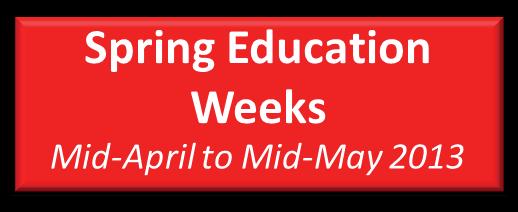
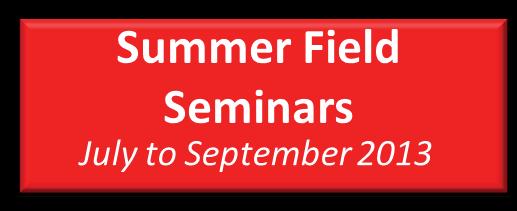

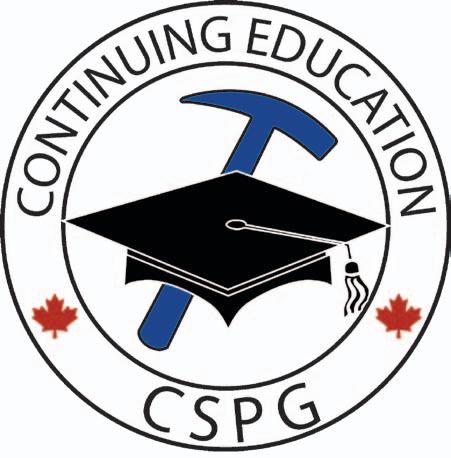
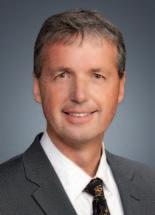
education : B.Sc. (Honours, Geological Sciences), Queen’s University (1980); Ph.D. (Geology), University of Calgary (1991).
e xPerience: Geologist/Geophysicist, Amoco Canada (1980-1993); Structural Geologist, Morrison Petroleum (1993-1996); Exploration Manager-Foothills, Northstar Energy (1996-1999); Principal, GeoConsultants Ltd. (1999-2010); President, Shale Exploration/Petroleum (2010-present); Adjunct Professor, University of Calgary (2005-present). Lecturer for numerous industry courses on Structural Geology and Fractures (1995-present).
ProFessionaL
memBershiPs: CSPG, AAPG, APEGA, CSEG.
csPg actiVities: Speaker at several conferences and luncheons; Structural Division Chair (1993-1994); Visiting Petroleum Lecturer (1995, 2010), Editor (Bulletin), Triangle Zone Volume – Special Issue (1996); Canadian Petroleum CSPG Executive, Program Director (2000-2001); CSPG/CSEG/CWLS Annual Convention Co-Chair – Recovery (2011); GeoConvention (JAC) steering committee (present).
aWards: CSPG Service Award; CSPG Tracks Award; CSEG/CSPG/CWLS Best-Integrated Geology and Geophysics Paper for the National Convention Geotriad; GeoCanada (2010), National Convention for the CSPG, CSEG, CWLS, GAC/MAC – Best Geology Paper.
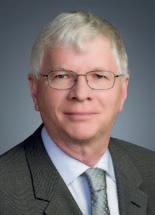
education : B.Sc. (Honours), University of Alberta (1977); M.Sc., McMaster University (1979); Ph.D., McMaster University (1984).
e xPerience: Petro-Canada (1983-1985); Geological Survey of Canada (1985-1998); Nexen Inc. (1998-present).
ProFessionaL memBershiPs: CSPG, APEGA, APEGS, AAPG, SEPM.
csPg actiVities: CSPG Conference Organization; Co-Organizer of 2009 CSPG William C. Gussow Geoscience Conference “Towards Sustainable Oil Sands Development.” Oct 5-7, 2009, Banff, Canada; Co-Chaired 1988 CSPG Conference on Sequences, Stratigraphy, Sedimentology: Surface and Subsurface (1,100 delegates); CSPG Technical Luncheon Presentations – 2009, 2004, 1997, 1995, 1996a, 1996b, 1993, 1987, 1985.
PuBLications : Bulletin of Canadian Petroleum Geology – 16 papers; CSPG Memoirs and others – 6 papers; Edited CSPB Books, Co-Editor of CSPG 1988 Memoir 15, Sequences, Stratigraphy, Sedimentology: Surface and Subsurface, Leckie, D.A. and Barclay, J.E. 2011. Gas Shale of the Horn River Basin – Discovery, Potential and Future, CSPG Publication; Numerous CSPG Core Conference and Field Trip publications; CSPG Gussow Conference Committee Chair – 2011/12.
aWards: CSPG Medal of Merit (2005), best paper in Canadian Petroleum Geology; CSPG Service Award 1996/97; CSPG Link Award 1995; CSPG Medal of Merit (1987), best paper in Canadian Petroleum Geology; CSPG Distinguished Lecturer 1986; CSPG Honourable Mention, Best Ph.D. thesis (1985); Several AAPG and SEPM awards.

education : B.Sc. (Geology, Honours), Dalhousie University (1977); M.Sc. (Geology and Geophysics), Carleton University (1979).
exPerience : Amoco, Aquitaine, Fekete & Associates, and Westward Energy (1977-1997); Co-founded Hume, Mann & Associates, which eventually became AJM Petroleum Consultants (1984); CEO of AJM Petroleum Consultants (2004-2011); Energy Resources Advisory Services, Partner, Deloitte (2011-present).
ProFessionaL
memBershiPs: CSPG, APEGA, AAPG, Member of AAPG Division of Professional Affairs.
csPg actiVities: Chairman of CSPG Insurance Committee (1999-2008).
aWards: CSPG Service Award (2005).

education : B.Sc. (Geology), University of Calgary (1998); M.Sc. (Earth and Atmospheric Sciences), University of Alberta (2004).
e xPerience: Anadarko Canada (2002-2006); Geologist, Canadian Natural Resources (2006-Present).
ProFessionaL
memBershiPs: CSPG, APEGA.
csPg actiVities: Treasurer Continuing Education Committee (2008-2011).
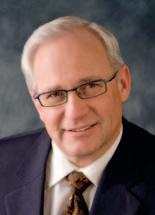
education : B.Sc. (Geology), University of Toronto (1981).
e xPerience: Exploration and Development Geologist, Unocal Canada Ltd. (1981-1992); Development and Oilsands Geologist, Gulf Canada Resources Ltd. (1993-1998); Consulting Oilsands Geologist, Durando Resources Corp. (1999-2006); V.P. Exploration Oil Sands, Southern Pacific Resource Corp. (2006-2009); Technical Director, Board, Canadian Heavy Oil Association (2008-2010); Consulting Oilsands Geologist, Durando Resources Corp. (2009-2012).
ProFessionaL
memBershiPs: CSPG, APEGA, CHOA.
csPg actiVities: Basin Analysis & Sequence Stratigraphy Division (2002 to 2009); Publication Indexing Committee (1983 to 2004); Conference Presenter: Geologic Considerations in Horizontal Well Placement for McMurray Fm Thermal Exploitation: Case Example, Surmont Alberta (1999). Nisku Sedimentology, Meekwap to Sturgeon Lake (1991). Application of 3-D modeling to Leduc Exploration (CSEG 1986).
aWards: CSPG Service Award (2011).

education : Diploma (Reservoir Engineering), SAIT (1983), B.Sc. (Geology), University of Calgary (1990).
e xPerience: Technical Sales and Services, Digitech (1990-1992); Manager, Log Library, Riley’s Datashare International (1993-1996); Sales Manager, International Datashare Corporation (1996-2002); Sales Manager, RECON Petrotechnologies (2002-2011); Technical Advisor, Canadian Discovery (2011-Present).
csPg actiVities: Transportation Committee GeoTriad (1998), Exhibits Chair CSPG / CSEG Convention (1999), Sponsorship Chair, Joint Annual Convention (2004, 2005).
aWards: CSPG Service Awards (various years).
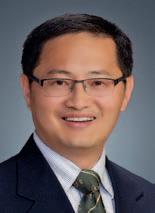
education : B.Eng. (Petroleum Geological Exploration), Southwest Petroleum Institute, P. R. China (1992); M.Sc. (Petroleum Engineering), University of Alberta (2002); Ph.D. (Petroleum Engineering), University of Alberta (2007).
e xPerience: SINOPEC China (1992-1997); Centre for Computational Geostatistics, University of Alberta (2003-2006); Geostatistician, Surmont geomodeling advisor, ConocoPhillips Canada (2006-2011); Principle geologist/ geomodeler, Statoil Canada (2011-present).
ProFessionaL memBershiPs: CSPG.
csPg actiVities: Chair of geomodeling committee (2007-2012); 2011 Gussow Conference organizing committee; Geomodeling session chair in GeoConvention (2008, 2009).
PuBLications: Published 20+ technical papers as principle or co-author relating to geostatistics, geomodeling, and reservoir engineering.
aWards: CSPG Volunteer Award (2007-2010), CSPG Service Awards (2011).
(Continued

education : B.Sc. (Geology), University of Calgary (1989).
e xPerience: Consultant Coal Geologist (1989-1995); Coal Geologist, ERCB (1995-present).
ProFessionaL
memBershiPs: CSPG, APEGGA.
csPg actiVities: Session chair CSPG conference.
PuBLications: Talks and posters in various convention programs; chapter co-author WCSB Atlas 1994.

education : B.Sc. (Geology, Honours), University of Saskatchewan (1990); M.Sc. (Geology), University of Regina (1997).
e xPerience: Saskatchewan Energy and Mines (1993-1998); Government of Yukon Energy and Resources (1998-2004); Starpoint/Acclaim/Canetic Energy Trusts (2005-2007); Harvest Operations Corp (2008-present).
ProFessionaL
memBershiPs: CSPG, AAPG, APEGGA, APEGS, GSA, SGS.
csPg actiVities: Technical Luncheon Committee (2006-present); Indexing Committee (2009-present).
Vision : I have always looked on the CSPG as a repository for the abundance of petroleum geology technical information concerning (but not restricted to) the petroleum regions of Canada. In addition, the Society provides an opportunity for networking and community outreach. In my vision, everyone working as a petroleum geologist in Canada finds much value in their membership to the CSPG and feels an obligation and desire to actively participate in the organization and in their community.

education : B.Sc. (Geology), University of Manchester, England (1973).
e xPerience: Geologist, Amoco Canada Petroleum Company (1974-1991); Manager of Geology, Crestar Energy (1991-1998); President, Geo-Help Inc. (1999-2004), Manager of Geoscience, AJM Petroleum Consultants (2005-2011), Director of Geoscience, AJM Deloitte (2011 to Present).
ProFessionaL memBershiPs: CSPG, AAPG, APEGGA.
csPg actiVities: Co-chair of Continuing Education Committee (2003-2006), Presented numerous papers, posters, and luncheon talks at various CSPG events.

education : B.Sc. (Earth Science), University of Toronto (1988); M.Sc. (Geology), University of Waterloo (1992); Ph.D. (Geological Science), Queen’s University (1997).
e xPerience: Geologist, Amoco and BP Canada (1997-2003); Sedimentologist, Devon Canada (2003-2006); Staff Geologist, Nexen Inc. (2006-present).
ProFessionaL memBershiPs: CSPG, AAPG.
csPg actiVities: CSPG Convention Short Courses Chair (1997), Joint Annual Core Conference Chair (2012, 2013).
aWards: CSPG Service Award (1997).
Vision : Programs at the CSPG are an important tool for the Society to deliver relevant and valuable services to our large and varied Membership. These programs work towards maintaining the Society’s high technical standards, professionalism, cohesion, and appeal to geoscientists in Canada and globally. We must strive to continually improve the Society’s Programs and implement new initiatives to keep CSPG relevant and useful to the Membership.

education : B.Sc. (Geology and Geophysics), University of Calgary (1999); M.Sc. (Geology and Geophysics), University of Calgary (2005).
e xPerience: Geologist, Talisman Energy (2000-2002); Geoscientist, Imperial Oil Resources (2003-Present).
ProFessionaL memBershiPs: CSPG.
csPg actiVities: SIFT Committee (1998-present), SIFT Committee Chair (2010, 2011).
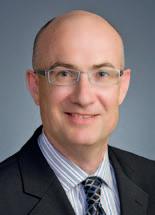
education : B.Sc. (Geology), Laurentian University (1985); M.Sc. (Geology), University of Alberta (1988).
e xPerience: Geologist, Dome Petroleum (1988); Geologist, Amoco Canada (1988-1998); Geologist, BP Canada (1998-2004), VP Resource Development, MEG Energy (2004-2011), Senior Advisor Subsurface, MEG Energy (Present).
ProFessionaL memBershiPs: CSPG, APEGGA, CHOA.
csPg actiVities: SIFT Committee (1992-1997); Environment Division Chair (2004-Present).
aWards: CSPG Volunteer Award (2007), CSPG Service Award (2010, 2011).
Detailed and accurate geology at your fingertips in Petra, GeoGraphix, ArcGIS, AccuMap, GeoScout and other applications for information contact: Joel Harding at 403 870 8122 email joelharding@geoedges.com www.geoedges.com
Western Canada: Slave Point, Swan Hills, Leduc, Grosmont, Jean Marie, Horn River Shales, Elkton, Shunda, Pekisko, Banff, Mississippian subcrops and anhydrite barriers in SE Sask., Bakken, Three Forks, Montney, Halfway, Charlie Lake, Rock Creek, Shaunavon, BQ/Gething, Bluesky, Glauconitic, Lloyd, Sparky, Colony, Viking, Cardium, Horseshoe Canyon and Mannville CBM, Oilsands Areas, Outcrops
Northern US Rockies & Williston Basin Geological Edge Set
Western Canada Geological Edge Set
North American Shales Geological Edge Set
Eastern US / Appalachian Basin Geological Edge Set
Texas & Midcontinent US Geological Edge Set
US Rockies & Williston: Red River, Mississippian subcrops & anhydrite barriers (Bluell, Sherwood, Rival, etc), Bakken, Three Forks, Cutbank, Sunburst, Tyler, Heath, Muddy, Dakota, Sussex, Shannon, Parkman, Almond, Lewis, Frontier, Niobrara, Mesaverde shorelines, Minnelusa, Gothic, Hovenweep, Ismay, Desert Creek, Field Outlines, Outcrops
Texas & Midcontinent: Permian Basin paleogeography (Wolfcampian, Leonardian, Guadalupian), Granite Wash, Mississippian Horizontal Play, Chat, Red Fork, Morrow, Sligo/Edwards Reefs, Salt Basins, Frio, Yegua, Wilcox, Eagleford, Tuscaloosa, Haynesville, Fayeteville-Caney, Woodford, Field Outlines, Outcrops, Structures
North American Shales: Shale plays characterized by O&G fields, formation limit, outcrop, subcrop, structure, isopach, maturity, stratigraphic cross-sections. Includes: Marcellus, Rhinestreet, Huron, New Albany, Antrim, Utica-Collingwood, Barnett, Eagleford, Niobrara, Gothic, Hovenweep, Mowry, Bakken, Three Forks, Monterey, Montney, Horn River, Colorado
Eastern US / Appalachia: PreCambrian, Trenton, Utica-Collingwood, Medina-Clinton, Tuscarora, Marcellus, Onondaga Structure, Geneseo, Huron, Antrim, New Albny, Rhinestreet, Sonyea, Cleveland, Venango, Bradford, Elk, Berea, Weir, Big Injun, Formation limits, Outcrops, Allegheny Thrust, Cincinatti Arch, Field outlines
Deliverables include:
-Shapefiles and AccuMap map features
-hard copy maps, manual, pdf cross-sections
-Petra Thematic Map projects, GeoGraphix projects, ArcView map and layers files
-bi-annual updates and additions to mapping -technical support
It is easy to assume that horizontal drilling was a single technological development. It is, in fact, a series of small advances in technology that, combined, have brought us to current capabilities. This process will continue to advance horizontal drilling activity into the future.
While early drilling was very much a hit and miss affair with the drill bit frequently straying out of the target formation, technology has made the process much more effective. The advances described in Table 1 are typically directed to speeding up the drilling process, staying in the target zone, and creating better hole conditions.
All of these improvements are the result of many steps of innovation and experimentation by individuals and companies around the world. The appropriate application of the technology varies considerably from play to play, area to area, and the type of hydrocarbon to be produced. While economics clearly weigh on these decisions, it is very clear that safety and environmental protection are also critical.
United States gas production peaked in 1973 and appeared on an inexorable decline. Exports from Canada bridged the gap between supply and demand for many years. Expansion of pipelines into the States during the 1990s greatly accelerated the volumes exported and rapidly depleted Canada’s conventional reserves. Tight supply pushed prices up and encouraged development of Liquefied Natural Gas (LNG) import facilities, and the search for other sources of natural gas.
U NCONVENTIONAL RESERVOIRS TO THE RESCUE
Strengthening prices encouraged the pursuit of lower-quality reservoirs. These were typically known gas-charged rocks with limited permeability that restricted the flow of gas into the wellbore. In many cases, the opportunities were lower-quality versions of existing reservoirs, but also included extracting gas from coals and shales. The
Downhole motors Placing the energy source closer to the drill bit
Geo-steering
Measurement while drilling (MWD)
Drill bit design
Refinement in the orientation of the drilling process
Placing sensors close to the drill bit to get real-time information
Increased bit life and penetration rate
Coil tubing A continuous drill string that can be rapidly tripped in and out of the wellbore
Specialised muds and other drilling fluids
Fluids designed for specific purposes
Mono-bores The drilling of a horizontal well without the need for intermediate casing in the vertical section
Digital data collection, transmission, and interpretation
Instantaneous transmission of drilling data to anywhere in the world
Multiple laterals The ability to drill a number of horizontal legs from a single vertical wellbore
Table 1. Advances in horizontal drilling.
focus of the industry moved from exploration to improved drilling and completion.
John Masters of Canadian Hunter Exploration Ltd. had shaken up the Canadian industry with the identification and development of the Elmworth Field in the Grande Prairie area of Alberta starting in the 1970s. The concept of substantial thicknesses of gascharged Cretaceous sediment, where the only challenge was finding enough porosity to store an economic volume of gas, created a revolution that ramped up production along the west side of the Western Canada Sedimentary Basin to over three billion cubic feet per day. The multiple porous zones in a Deep Basin vertical wellbore encouraged the development of new completion techniques. However, the drainage area for each individual sand was very small so that evercloser spacing between wells was required to achieve reasonable recovery factors. The concepts developed in the Deep Basin of Alberta were later applied to many areas of the United States where the term basincentred gas was used.
Increase in drilling efficiency
Ability to accurately target a specific downhole interval
Early identification of problems such as straying out of target and ability to rectify
Savings in rig time and tripping costs
Savings in rig time and tripping costs
Better hole conditions, minimising formation damage
Significant time saving
Problems and solutions can be identified in real time by experts far removed from the well site
Reduce drilling costs, minimize surface footprint, consolidate production facilities
In the U.S., George P. Mitchell, head of Mitchell Energy and Development Company, had been experimenting with drilling and completion of the Barnett Shale in the Fort Worth Basin, Texas since the 1980s. He did not discover the gas, the existence of which was well known to the industry, but through twenty years of perseverance, he was able to develop drilling and completion techniques that would enable production of gas from exceedingly low-permeability rock. He first experimented with horizontal drilling of shales in 1991, but the tests were unsuccessful and it was not until 1998 that horizontal drilling became a viable approach.
The focus of early horizontal drilling on conventional reservoir rocks meant that there was little need for significant fracture treatment to initiate production. As the technology was applied to increasingly lower permeability rocks, just accessing more of the reservoir was inadequate to create a successful producing well.
Typical oil field regulations at the time required each artificially fractured zone to be tested separately. This would have meant that a multistage completion program in a horizontal well would have taken a considerable length of time and would have been prohibitively expensive. Therefore, early horizontal wells requiring fracture stimulation were typically completed with a single fracture treatment and little control over where that fracture developed in the wellbore. These projects probably only stimulated the heel of the wellbore, drastically limiting the benefits of a horizontal well. Relaxed regulations that allowed commingling a series of stimulated zones enabled companies to perform a number of fracture treatments followed by a single production test, resulting in considerable savings in time and money.
Techniques to efficiently isolate sections of the horizontal wellbore, perform a fracture stage, and move on to the next interval without the need to trip out of the hole became critical to the completion program (Table 2). Successful exploitation of horizontal wells were increasingly dependent on advances in fracture design.
Debate over the pros and cons of open-hole versus cased-hole completions has continued to the present. In an unconsolidated reservoir or a formation prone to caving into the wellbore, slotted liners could suffice to maintain hole integrity.
While open-hole techniques allow maximum inflow into the wellbore and consequently high early productivity, there is limited ability to control where the fracture forms in the wellbore. The fracture will take the path of least resistance and may follow an existing fracture path. Cased holes and perforation of specific intervals does impede inflow into the wellbore but enables specific zones to be targeted or closed off as necessary. The ability to simply and effectively isolate separate sections of the horizontal wellbore was a turning point in the evolution of horizontal completions in unconventional reservoirs.
Recent experimentation has been largely directed towards determining the optimum spacing and size of staged fractures. Both are influenced by the rock properties, thickness of target zone, and the fluid to be produced. The completion for a ductile, thin reservoir with viscous oil over formation water will be very different from the completion in a brittle, thick, gas-charged zone in the Deep Basin. The general trend in many reservoirs
has been towards more numerous, smaller fracture treatments. Early wells may have had two to four fracture stages while in late 2011, Packers Plus Energy reported performing a sixty-stage open-hole completion in the Marcellus.
When fracture fluids, additives, injection pressures, volumes – along with the timing, type, and quantity of proppant injection – and many other variables are incorporated into the completion decision it is obvious that there are an infinite range of possibilities. Even the biggest companies are unable to test all the possible combinations; therefore, there is a big incentive for a company to copy the methods of their competitors or to form consortia to test various techniques. The range of possible input parameters along with subtle variations in reservoir quality, condition of wellbore, and expertise of the completion crew make it very difficult to compare relative success of different techniques.
The complexity of the completion process has reached a point where the completion may be at least as costly as the drilling of the well. Deep horizontal wells with many large fracture treatments can easily cost more than ten million dollars. It is therefore vital that as much data as possible be gathered
Isolation of sections of horizontal wellbore
Powerful pumping units and related equipment
Fracture fluid design
Proppant design
Spacing and size of fracture treatments
Simultaneous fracturing
to understand how effective the drilling and completion process has been. Shortcuts on measuring results can be extremely costly in the long term.
The application of microseismic has been a boon to the multi-stage fracturing business. The ability to measure the three-dimensional location of fracture propagation events in the area surrounding the wellbore is vital to understanding the effectiveness of well completions. This subject has been well covered in the series of articles by Shawn Maxwell in this publication (issues February to July 2012).
If we do not understand the effectiveness of an individual completion, it becomes very difficult to assess effective drainage, recovery factor, well-spacing requirements, fracture spacing, fracture size, and all the other factors relevant to a successful development program. The acquisition of useable microseismic can be a very costly process, but it may be vital to our future understanding of reservoir performance, determining the need for re-fracture programs, or down-spacing of wells. The short-term savings by skimping on this information may have a significant negative impact on future productivity and recovery factors.
Efficient opening and closing of sections of horizontal wellbore using packers and valves that could be remotely operated
Technology to rapidly pump large volumes of fracture fluid into a zone in the wellbore
Additives to the fracture fluid for purposes such as reduce friction in the wellbore, effectively carry proppant into the reservoir, reduce formation damage, etc.
Proppant used to keep fractures open in the reservoir – varies in grain size, strength, roundness, consistency; may be a natural sand or manmade ceramic product
Adjusting the fracture size and spacing between treatments in the horizontal wellbore
Fracturing of adjacent wells at the same time to develop more complex fracture systems rather than linear fractures that may extend long distances from the wellbore
Ability to perform a fracture treatment in a discrete interval and move to the next interval without tripping from the wellbore
Significant pressures to rapidly breakdown a formation and create fractures reaching far into the reservoir
More effective fracture treatments
Using the best proppant to achieve a particular goal, especially in highpressure environments where the proppant may not effectively hold the fracture open
Inducing permeability in a maximum volume of reservoir rock while minimising energy losses and waste through fractures growing out of zone
Potential to increase concentration of fractures and consequent productivity within a formation volume Table 2. Advances in horizontal completion technology.
The Gussow Geoscience Conference held November 6th-8th, 2012 in Banff attracted 67 participants. The theme, Hydraulic Fracture Stimulation: Science, Society & Environment, drew a strong and diverse gathering to the Banff Centre and the technical talks were well received by all in attendance.
Hydraulic fracturing is both a topical and at times controversial subject and this year’s Gussow was convened to gather industry, academic, and government specialists to present and discuss materials to help facilitate and foster discussion on hydraulic fracturing. There were 22 speakers, including a keynote address from George King of Apache. Speakers travelled from British Columbia, Alberta, USA, and
UK to help give a broader perspective on hydraulic fracture stimulation.
This year’s format included four themed sessions: The Science and Engineering of Hydraulic Fracturing; Environmental Impacts – Earthquakes/Seismicity; Environmental Impacts – Surface/Subsurface Water Impacts; and Energy: Demand, Supply, and Regulations. An icebreaker reception was held on Tuesday night that allowed the delegates and speakers the opportunity to network and continue to talk about the sessions. APEGA hosted a dinner on Wednesday night that allowed for further networking opportunities.
The success of this year’s meeting was due in part to our sponsors: Nexen Inc.,
•Now offering a proprietary core index on-line via STONECODE HUB.
•Over 11,000 Carbonate and Clastic core interval descriptions in the WCSB available.
•If you cannot visit the core, the SCG interpretation can visit you, on your desktop.
•For a full listing of available core descriptions g o to www.scgltd.com and follow the links.


Stoakes Consulting Group Ltd
APEGA, and Schlumberger. We could not have run a successful event without their support. We also want to thank our speakers, session chairs, and all those who participated.

Suite 402, 103 - 10th Avenue NW, Calgary, AB, Canada T2M 0B4 ph: (403) 262-6003 fax: (403) 265-4662 email: stonecode.scg@shaw.ca

May 6 -10
Telus Convention Centre and ERCB Core Research Centre
ABSTRACT SUBMISSION IS NOW OPEN
integration is coming . The annual CSEG, CSPG, CWLS convention will be held at the TELUS Convention Centre and ERCB Core Research Centre May 6th10th 2013.
Please visit www.geoconvention.com to submit your abstract.
economic disciplines will be heartily welcomed.
Presentations that integrate the various disciplines of the geosciences, engineering, technology, the environment, and business are preferred.In order to offer something for everyone, we are designing a technical program that will include large, general themes that encourage multi-disciplinary contributions and will focus on various specific areas within a general topic. We are also planning a range of specialized technical sessions focused on advances in specific disciplines.
GeoConvention 2013 is shaping up nicely. The technical committee has laid the keel for an exceptional technical program and is busy gathering the materials to construct the rest of a fine ship. You are invited to join this exciting project and contribute to the hull, decks, staterooms, engine, and superstructure of the mighty vessel Integration. Your abstracts can be submitted via the convention site www. geoconvention.com. Abstract submission will close on January 7th, 2013 so please bend your back to the task as soon as possible – it would be a shame if you found yourself having to work through Christmas vacation to take your abstract from excellence to perfection. Abstracts that address the combination of efforts from geoscience, engineering, business, environment, regulatory, political, and
n Heavy Oil and Oil Sands
n Unconventional Resources
n Mature Fields
n Unconventional Petrophysics
n Seismic to Simulation
n Best of SEG/EAGE
INCREASE YOUR CORPORATE PROFILE!
Space on the exhibit floor is again proving to be very popular and we anticipate a fully sold venue. Some of the best value at the convention comes from exhibit floor interaction, so don’t be shy. Meet colleagues and have energetic discussions in public. Learn about new innovations in software and fieldware. Engage regulators in a cooperative atmosphere. The exhibit floor is a buzzing hive of geoscientific endeavour; make sure that you have a presence there.
n Emerging Technology
n Frontiers
n Arctic
company may be one of these far-sighted organisations; if not, maybe they should be. There are customisable sponsorship options still available. Find out who is in charge of these decisions in your workplace and have a word with them.
n Core Conference
Interested in Exhibit, Sponsorship or Advertising opportunities for the 2013 Convention? Please contact Alyssa Middleton, Assistant Convention Manager, for more information: alyssamiddleton@shaw.ca, 403-453-0181
Geo2013_Reservoir_ halfpgAd_Nov.indd 1
Sponsorships help to keep the GeoConvention afloat. We are fortunate to have a group of companies who see the value in an annual event whose main purpose is to share knowledge in such a way that we will all benefit. These companies are not merely generous –they know that value flows to them from their involvement with a large group of geoscientists and their colleagues. Your
The 2013 convention will have something for everyone – a top-tier technical program, networking events, expert keynote speakers, and interesting and thoughtprovoking luncheon speakers, as well as the chance to extend your professional reach by attending a short course or getting in touch with the earth again during a field trip.
Over the next four months think conventional thoughts, rest up, and prepare. Be ready for GeoConvention 2013 – integration
Be sure to visit www.geoconvention.com for the latest developments.


Stanley Slipper Gold Medal for Outstanding Career Contributions to Oil and Gas Exploration in Canada
Roger W. Smith
r .J.W. Douglas Medal for Outstanding Contributions to the Understanding of Sedimentary Geology in Canada
Guy Plint
Honorary Membership for Distinguished Service to the Society
Andrew Miall
William (Bill) May
link Award for Best Presentation –Technical Luncheon Series
John Suter
Medal of Merit for Best Paper Related to Canadian Petroleum Geology
Milovan Fustic, Barry Bennett, Jennifer Adams, Haiping Hunang, Bill MacFarlane, Dale Leckie, and Steve Larter
“Bitumen and heavy oil geochemistry: a tool for distinguishing barriers from baffles in oil sands reservoirs”, Bulletin of Canadian Petroleum Geology, December 2011, p. 295-316
President’s Award for Outstanding Service by a CSPG Member
Kirk Osadetz
H.M. Hunter Award for Distinguished Service to the Society
Lisa Griffith
Tracks Awards for Members Who Have Set New Standards of Excellence
Philip Benham
Nathan Bruder
John Cody
Darcie Greggs
Mike LaBerge
Ben McKenzie
Tom Sneddon
Service Awards for Members who have Served the Society for over Five Years
James Ablett
Linden Achen
Norbert Alwast
Alexis Anastas
George Ardies
Peter Aukes
Andreas Bayer
Tim Bird
Graeme Bloy
Chuck Buckley
Mark Caplan
Allan Carswell
Jean-Yves Chatellier
Richard Chisholm
Nancy Chow
Andre Chow
Penny Christensen
David Clyde
Penny Colton
Debbie Cook
Andrew Cook
Barrie Dargie
Tim de Freitas
Foon Der
Keith Dewing
Ian DeWolfe
Steve Donaldson
Tina Donkers
Dave Drover
Bob Earle
Markus Ebner
Ashton Embry
Richard Evoy
Patrick Fothergill
Jocelyn Frankow
Lloyd Freeman
Riona Freeman
Jean-Francois Gagnon
David Garner
Steve Grasby
Aaron Grimeau
Ayaz Gulamhussein
Tony Hamblin
Peter Harrington
Peter Hay
Doug Hayden
Greg Hayden
Fran Hein
Denise Hodder
John Hogg
Norm Hopkins
Kristy Howe
Steve Hubbard
Michele Innes
Dale Issler
Glenn Karlen
Don Keith
Ian Kirkland
Peter Kouremenos
(Continued on next page...)



petrographical & sedimentological descriptions for samples (thin section - fluid inclusion studies) conventional vertical/horizontal wells operations geology
Dan Krentz
Carrie Kukko
Shaun Lafleur
Larry Lane
Denis Lavoie
Dale Leckie
Sid Leggett
Greg Lynch
Robert MacNaughton
Dave Mans
Margot McMechan
David Middleton
Steve Minions
Ryan Mohr
David Morrow
Jeff Packard
Regan Palsgrove
Brenda Pearson
Per Kent Pedersen
John Peirce
Guy Plint
Frank Pogubila
Bob Potter
Brian Pratt
Mark Radomski
Indy Raychaudhuri
Trent Rehill
Weishan Ren
Claude Ribordy
Mike Rogers
Justine Sagan
Terry Sami
Chris Seibel
Darren Singleton
Heather Slavinski
Randy Smith
Lavern Stasiuk
Glen Stockmal
Naomi Storey
Mike Swain
Martin Teitz
Clint Tippett
Tim Truax
Tony Wain
John Waldron
Michael Webb
Gerald Wedland
Laurie Weston Bellman
Jay Williams
Nick Wilson
Keith Yaxley
Colin Yeo
volunteer Awards for Members who have Served the Society for up to Five Years
Johanna Alvarez
Heather Archibald
Nick Austin
Ryan Axani
Olena Babak
Kent Barrett
Kelly Batten Hender
Ali Beken
Ian Bell
Barry Bennett
Khaled Benzaoui
Kyla Bishop
Jeff Boisonneault
Mary Borrero
Edlyn Bruni
Gary Bugden
David Campagna
Clarke Campbell
Octavian Catuneanu
Burns Cheadle
Guoxiang Chi
Christopher Collom
Doug Colvin
Ryan Cook
Andrew Couch
Jonathan Cribb
Leena Davis
Eugene Dembicki
Noel Devere-Bennett
Eva Drivet
Steve Dryer
Rory Dunphy
Kyle Durocher
Marc Enter
Jeff Fisher
Colleen Flynn
Francis Fortin-Morin
Martin Fowler
Bill Gatenby
Daniel Gee
Sasan Ghanbari
Chad Glemser
Wanda Grisak
Tony Habib
Fran Haidl
Anne Hargreaves
Tim Hartel
Tracy Hay
David Hills
Don Hladiuk
Amir Hosseini
Greg Hu
Biyi Ishola
Bryce Jablonski
Thomas Jerome
Tracey Jungwirth
Kevin Keogh
Larraine Kish
Melanie Klucker
Nate Kreiger
Lawrence Kwak
Willem Langenberg
Adam Leather
Matthew Leforte
Chris Leppard
Alex MacNeil
Roger Macqueen
Jonathan Marshall
Ryan Martin
Jane Marzetti
Derek Mawbey
Darin McBeath
Tannis McCartney
Darin McCollum
Rick McCulloch
Les McMillan
Geoff Minielly
Amanda Mitander
Aliyyah Mohamed
Alishah Nayani
Andrew Nicol
Brett Norris
Rob North
Taylor Olson
Amanda Perrot
Kyla Poelzer
Ken Potma
Garrett Quinn
Mark Rabin
Diana Ramirez
Melanie Regehr
Gerry Reinson
Andrew Riben
Cindy Robinson
Mike Rogers
Kristin Rohr
Sandra Rosenthal
Jen Russel-Houston
Armin Schafer
Glenn Schmidt
Jacey Seebach
Megan Simons
Stasia Skappak
Catherine Skilliter
Geoff Speers
Meghan Speers
Stan Stancliffe
Rudy Strobl
Michelle Surette
Scott Thain
Damien Thenin
Dragana Todorovic-Marinic
Brad Torry
John Townsley
Elizabeth Turner
Grant Wach
Jane Wang
Cole Webster
Renjun Wen
Marissa Whittaker
Rick Wierzbicki
Andrew Willis
Elizabeth Willson
Dan Wright
Tiffiny Yaxley
Stefan Zanon
Yi Zhao

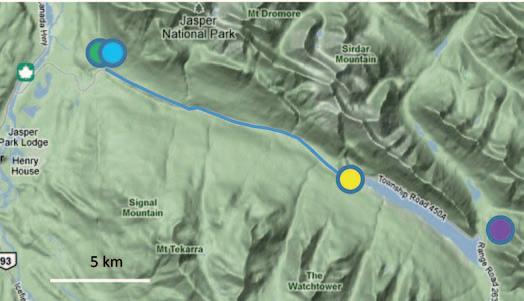
As in other Front Ranges thrust sheets within this region, the stratigraphic succession exposed in the Chetamon thrust sheet spans Cambrian to Triassic strata, and perhaps locally, part of the Jurassic Fernie Formation. The Pyramid thrust sheet, immediately SW of and parallel to Medicine Lake, contains both a thick succession of Neoproterozoic rocks (Miette Group) and Lower and Middle Cambrian rocks that are characteristic of the Main Ranges. Southwards, the Snaring thrust and the Jasper thrust, merge smoothly with the hanging wall of the Pyramid thrust, while the Borgeau Thrust merges with the footwall of the Pyramid thrust (Mountjoy and Price, 2003; Mountjoy et al., 2003). The steeply dipping strata control orientation of the Maligne Valley and result in a tendency towards slope failure. The extensive landslide debris and other Quaternary deposits make resolution difficult for the complex structural relationships in the region. Glacial steepening the valley into a classic U-shape resulted in some landslides onto the glaciers during the Ice Age (Roed, 1964). Fallen rock provides insulation and rock glaciers currently in the valley are Ice Age leftovers.
trailhead: Maligne Canyon – From Highway 16, turn east onto Maligne Lake Road, and proceed 2.3 km and turn on the Sixth Bridge access road (near the confluence of the Maligne and Athabasca Rivers. A trail leads from the parking lot and picnic area. To reach the viewpoint at the north end of Medicine Lake simply continue down Maligne Lake Road to one of several parking areas adjacent to the dry streambed and the lakeshore.
distance: Maligne Canyon trail (7.4 km return) proceed from sixth bridge across to north side of canyon and upstream to first bridge and the teahouse. Moderate elevation gain. A shorter version of the hike (done by the tourists hordes) can be done from the Teahouse Parking area. For the Medicine Lake portion of the visit, there is no real trail but it is interesting to wander in the karsted rubble-filled dry streambed and along the shores of Medicine Lake.
One post-glacial slide brought a mass of Palliser Formation rubble from the NE side of the valley to partially block Maligne River, thus creating the mysterious Medicine Lake. Karsting in the carbonate rubble suggests the slide is thousands of years old. Medicine Lake seasonally shrinks to small ponds in the winter and fills in the summer. The lake is so named because the First Nations believed that Big Medicine was required to cause such a phenomena. Medicine Lake has no visible outlet and only fills to overflowing once every three to five years. One researcher placed dyes in the lake and saw they reappeared half a day to a week later in a series of springs between spectacular Maligne Canyon (16 km distant and 410m lower) at Lac Beauvert at Jasper Park lodge (Brown, 1970). The underground drainage (at a maximum rate of 24m3/second) is a complex network of caves and fracture systems whose flow rates and outlets depend on the water level of Medicine Lake. Prior to the establishment of the park, the presumed drainage outlets of the lake were plugged with magazines and old mattresses in a futile attempt to prevent its cyclical and inevitable disappearance. This is now frowned upon!

Narrow cleft incised in the Devonian Palliser Fm at Maligne Canyon. Its sharpness suggests structural control perhaps even an unroofed cave system (Gadd, 2008) A large pothole has been left behind by erosion and is now vegetated.

reFerences:
Brown, M.C. 1970. Karst geomorphology and hydrology of the lower Maligne Basin, Jasper, AB. Unpub. Ph.D. thesis, 178p.
Mountjoy, E.W., and Price, R.A. 2003. Geology Athabasca Falls, Alberta. GSC Map 2007A. Mountjoy, E.W., Patenaude, C., and Price, R.A. 2003. Southesk Lake. GSC Map 1942A. Roed, M.A. 1964. Geology of the Maligne Valley Jasper National Park Area. Open File Report 1964-01. Alberta Geological Survey. (http://www.ags.gov.ab.ca/publications/ABSTRACTS/OFR_1964_01.html)
The Reservoir Committee welcomes contributions from our readership to this series. If you wish to offer a submission to Go Take a Hike on your favourite hike of geological interest, email the Reservoir at Emma.MacPherson@cspg.org for more information.
Karsted landslide debris sags into a dry creek at the exit of Medicine Lake. Underneath is thought to lay an extensive cave system that transports water from the lake to Maligne Canyon.
A stranded pothole (white arrow) formed by the current-swirled boulders left behind in it.
Karst and fractures in the bedrock create numerous pathways for the water. Here a heavy flowing spring (blue arrow), likely from Medicine Lake, joins Maligne River.
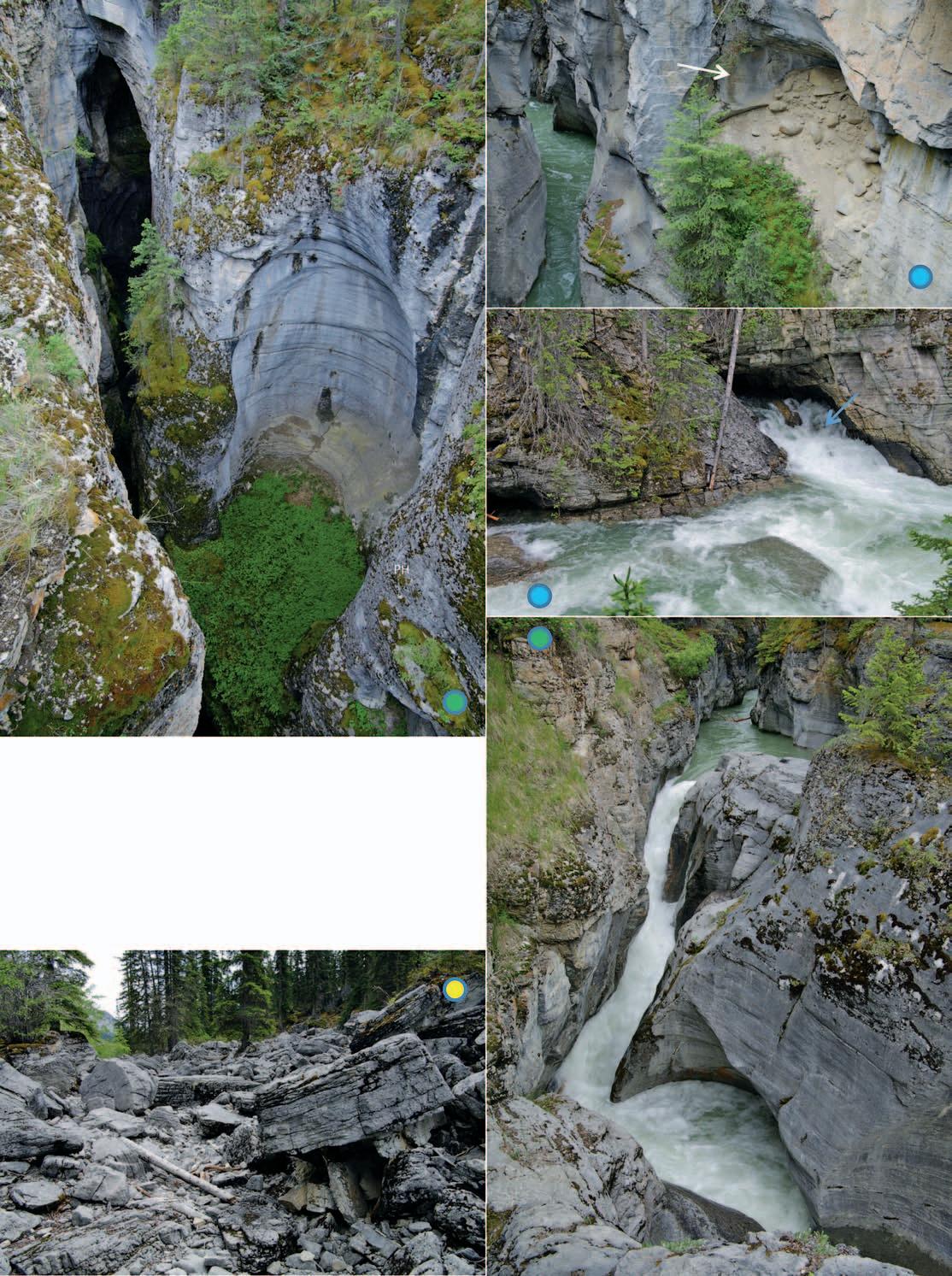
Lower falls at Maligne Canyon. In some of the polished limestone one can observe scattered brachiopods, cephalopods, and crinoid columnals. Note the straight path of the channel from the distance to the waterfall. A small fault or fracture system likely controls the route.
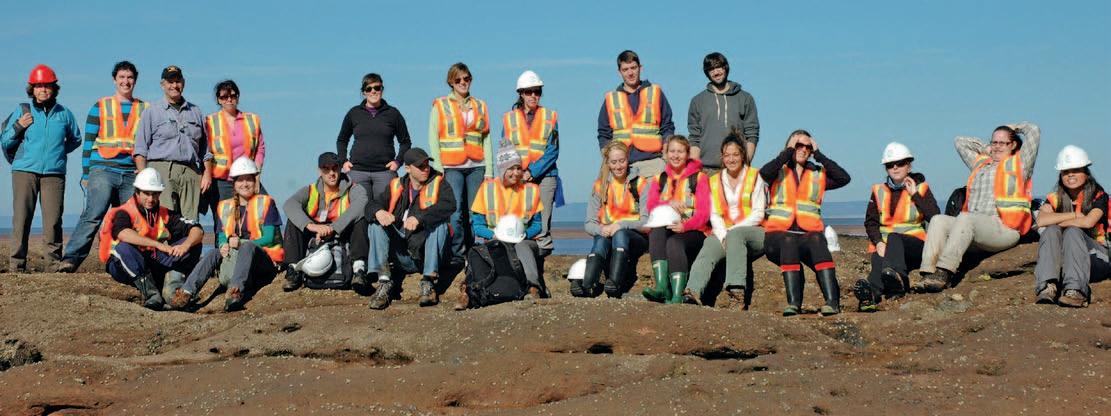
The 62nd Annual Atlantic Universities Geoscience Conference (AUGC) was held this year over the weekend of October 18th to 20th in Halifax, Nova Scotia, hosted by Dalhousie University. The conference began with a social on the 18th held at the Maritime Museum of the Atlantic in downtown Halifax. The social included a mini Challenge Bowl, won by the team from the University of New Brunswick.
Students had the choice of attending one of four field trips offered on the 19th. Both CSPG representatives chose to attend a trip to the Bay of Fundy led by Drs. Grant Wach and Elizabeth Kosters. The trip started on a Holocene tidal flat before winding farther around the bay to a Carboniferous/Triassic unconformity. Trip highlights included an outcrop of the Horton Bluff Formation, which has recently been explored as a potential shale gas play. The day was capped off by a cruise around the Halifax Harbour with time for everyone to socialize and enjoy a great live band.
Saturday the 20th was a day of talks and a poster session held on the Dalhousie campus. The CSPG booth was well attended by students and information about the Student Industry Field Trip (SIFT), the Undergraduate Awards and Student Event Grants was readily available for the students. The talks and posters were very well done, with a great diversity of topics and very high quality presentations. The awards banquet that night at Murphy’s on the Water included fantastic talks by Bob Ryan (Nova Scotia Department of Natural Resources) and
Dr. Sandra Barr (Acadia University), who has attended thirty-seven AUGCs so far. CSPG presented an award for the best talk related to petroleum geology to Lianabel Selviz of Memorial University, who had this to say about her win:
“As this year’s recipient of the CSPG award at the Atlantic Universities Geoscience Conference, I wish to express my thanks to the CSPG for motivating undergraduate students pursuing an honors thesis, like myself. It has been an honor to represent Memorial University at AUGC 2012, and of course, to be selected for the Best Petroleum Geology Presentation Award by the CSPG. With your generosity, I will be further assisted in achieving my education and career goals. This award is extremely valuable for me, contributing to savings or other training expenses for my thesis that may arise. With my project, I aim to cooperate in the development of a new oil enhancement plan for the Norne Field, and having the experience to present my work this past October has been highly important in this process.”
This conference was a great opportunity for the CSPG representatives to speak directly with students about the role that the CSPG can play in their academic careers. It was particularly encouraging to see the level of collaboration between the eastern schools and the caliber of work that these students are achieving. Kudos to the organizing committee – John Hirschmiller, Jimmy Burg, Dawn Tobey, and Nicole Marshall – for putting together a fantastically well-organized conference that
showcased the research being done at the Atlantic universities while presenting an opportunity for students to network and socialize.







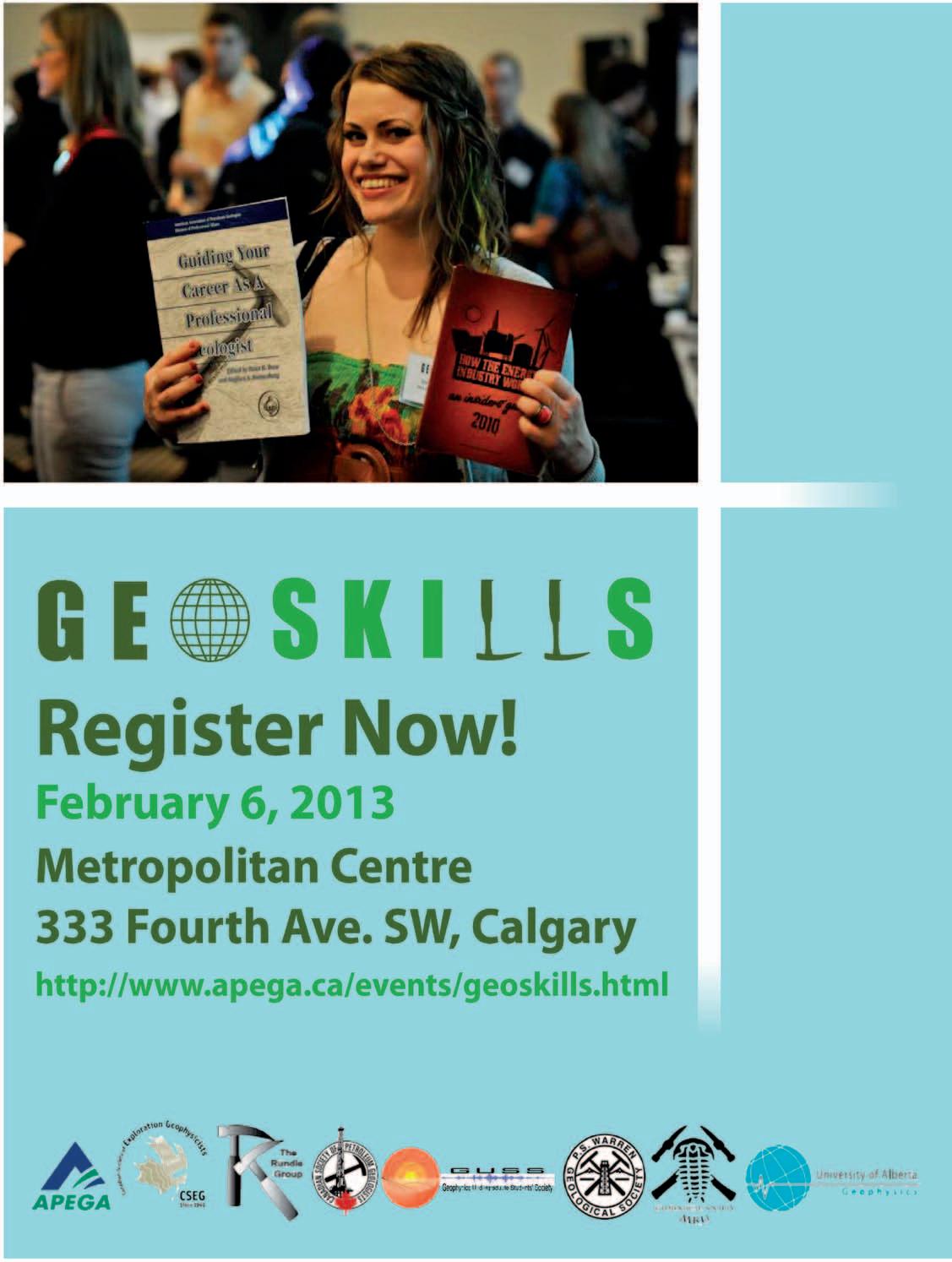

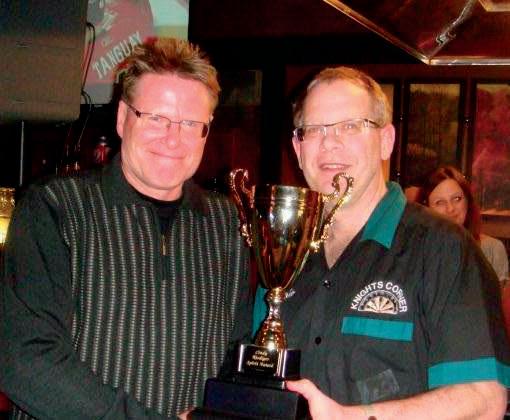



Notes on regulatory issues for industry geologists from their colleagues at the Energy Resources Conservation Board (ERCB)
The ERCB recently released a discussion paper1 on regulating unconventional oil and gas in Alberta. This article is based on the executive summary of that document.
Alberta is experiencing a steady decline in conventional oil and natural gas reserves after nearly a century of production. Conventional oil production peaked in 1973, while conventional natural gas peaked more recently in 2001. This decline is not unique to Alberta. The oil and gas industry, quite naturally, has identified and produced the most accessible resources and bypassed those beyond its technological and economic reach.
However, technological advancements now allow companies to pursue

Here’s how:
“unconventional” oil and gas resources that were previously ignored. Although still in its infancy in Alberta, application of these technologies will undoubtedly lead to increased development of a rich and largely untapped supply of unconventional hydrocarbons.
The ERCB is clear in its mission: to ensure that the discovery, development, and delivery of Alberta’s energy resources take place in a manner that is fair and responsible, with due regard for public safety, environmental protection, and resource conservation.
As interest in developing these unconventional resources increases, the ERCB is working to ensure that effective regulation is in place. This is nothing new. Throughout its 75-year history, the ERCB has proactively adapted its rules and processes in response to new issues
and changes in the energy industry. The ERCB is again taking action to ensure its regulatory requirements are appropriate by developing a new framework to govern unconventional oil and gas development.
The ERCB’s conventional regulatory framework is based on the development of discrete oil and gas pools produced through vertical wellbores on single-well pads. These consist of “reservoir” rock that has good porosity to store oil and gas, good permeability to allow fluids to move easily through the rock, and a seal to trap the oil and gas. These pools may be difficult to discover, but once discovered, are relatively easy to delineate through seismic or subsequent drilling. Conventional wells drilled into these pools typically drain oil and gas from large areas, often hundreds of hectares per well.
(Continued on page 36 ...)
2013 membership fees are now due - renew your membership online today!
Logon at www.cspg.org
Username = your membership #
Default Password = first four letters of your last name then your membership # (all lowercase, no spaces)
Click My AccountBilling , then
Proceed through steps to payment, you will receive a confirmation by email .
Please consider making a donation to the CSPG Educational Trust Fund, which funds educational programs to inspire individuals to pursue a career in petroleum geoscience. You can make a donation at the same time as your membership renewal.
If you are having trouble logging in please call the office at 403-264-5610
Has your contact information changed? Please make the necessary updates in your online profile.
Currently, the ERCB requires conventional development applications for each separate activity: drilling a well, laying a pipeline, or building a processing facility. Rules can be applied to specific pools for such things as enhanced recovery projects, production rate limitation, gas conservation, or good production practice.
Technology advances – horizontal drilling and multi-stage hydraulic fracturing – facilitate development of previously uneconomic oil and gas resources in more traditional formations like the Cardium and Viking, as well as emerging resource plays like the Duvernay Formation.
Application of these new technologies not only opens up new economic opportunities but also exposes new risks. Unlike conventional hydrocarbon pools, unconventional resource accumulations require larger-scale development and much more infrastructure (wells, roads, and other facilities).
The population of Alberta has increased rapidly in recent years, with an additional million people in the last decade. This adds pressure and competing interests
for Alberta’s landscape. Non-industry stakeholders expect to have a say in energy projects that may affect them, are more aware of environmental issues, and have concerns related to the impacts of hydraulic fracturing and related energy development activities.
The new regulatory framework must evolve to meet these new challenges, to provide all Albertans with the assurance that the system effectively manages any risks associated with oil and gas development, to ensure efficiency in the regulatory system for industry, and to deliver the policy outcomes established by the Government of Alberta.
Although no formally-accepted definition of “unconventional” resources exists, the term generally includes shale gas and oil, coalbed methane, and tight oil and gas. Alberta’s oil sands resources are also considered unconventional and are already subject to strict ERCB regulations. Information on how the ERCB is working to improve the oil sands regulatory framework can be found at www.ercb.ca.
The chemical composition of unconventional
oil and natural gas is essentially the same as their conventional counterparts. The term “unconventional” simply refers to how they are produced and the types of rock in which they are found.
However they are defined, it is clear that Alberta’s potential for unconventional resource development is enormous. The ERCB has conducted detailed resource assessments of some of the most promising shales in the province – the results underscore the magnitude of the potential. 2
Alberta’s existing oil and gas regulations have served the province well. Not only do they help protect Albertans and safeguard the environment, they make certain that our valuable energy resources are developed without waste.
While the current regulatory framework for oil and gas development provides a solid foundation, the ERCB understands it can build upon this base to address the unique issues, risks, opportunities, and challenges posed by unconventional resource development.

As with all energy regulation, this new framework will meet three objectives: clearly identify and mitigate potential risks to public safety, the environment, and the resource; ensure orderly development; and avoid imposing unnecessary regulatory burden on industry.
PLAy-F OCUSED AND R ISK-bASED Unconventional developments, particularly resource plays, can require dense infrastructure extending over broad areas. The nature of this development results in the challenges noted earlier: being more regional than has been the case with conventional development.
To meet these challenges, the ERCB’s new framework is based on two basic principles. First, risk-based regulation – regulatory responses that are proportional to the level of risk posed by energy development. Second, play-focused regulation –regulatory solutions tailored to an entire “play” to achieve specific environmental, economic, and social outcomes.
ERCB staff evaluated the risks of unconventional development through a survey of other jurisdictions where shale gas was being developed. The findings fall into three categories: water management (including volumes used and concern about groundwater contamination); hydraulic fracturing (understanding fracture propagation, ensuring containment, interwellbore communication, and potential to induce seismic events); and cumulative impacts (fragmentation of the landscape, truck traffic, emissions, noise, and dust).
The ERCB looks at a “play” as an area of oil and gas development that is determined mainly by geology, geographic area, the properties of the resource, and the technology required to develop that resource. Surface impacts are also considered where various land uses may be affected by unconventional development.
The play concept differs from the current regulatory model in which development generally occurs on a well-by-well basis. Under the new framework, the ERCB will formally declare “plays” based on their unique qualities and the level of risk that development could pose, and then apply regulatory requirements to those ‘declared’ plays.
While the existing ERCB framework will serve as a baseline that must be followed,
the requirements may be modified or superseded by play-focused requirements where appropriate. The ERCB will clearly identify changes to, or deviations from, baseline requirements for each declared play.
An overall play development plan will use a performance-based regulatory approach to manage the effects of a regional nature, rather than prescribe how outcomes must be achieved. The ERCB will encourage a group of operators to draft multi-operator play development plans to show how the play-specific outcomes will be achieved.
These plans will offer operators flexibility in how the regulatory outcomes are achieved. The ERCB believes that collaboration on play development plans is the most effective way to achieve regulatory outcomes, and strongly encourages companies to consider play-focused operator groups early in the development process.
Such collaboration among companies – and with the local authorities – will optimize infrastructure needs and placement, sharing of information and knowledge, and a onewindow approach for communication with stakeholders.
Play development plans must include enough detail to show how the key challenges will be addressed.
Complete play development plans will not always be possible early in the process. Since each operator may undertake development at a different pace, have different capital budgets, and use different approaches, reaching consensus on every aspect of development could be difficult.
As a precursor to collaborative planning from all active operators, the ERCB will require each company to submit a project plan for its own lease holdings within the declared play. Companies with adjoining leases will be encouraged to submit joint project plans.
These project plans must provide enough detail on five key challenge areas – water management, surface infrastructure development, reservoir management, stakeholder engagement, and life-cycle wellbore integrity – to demonstrate how these issues will be adequately and effectively managed.
To respond to these challenges and others
that could arise in the future, the ERCB has established critical outcomes that reflect its regulatory mandate and take into account the nature of unconventional resource development. These outcomes include:
• Water management – maintain a sustainable level of non-saline water use and the quality of surface water and non-saline groundwater.
• Waste management – conserve resources, minimize waste, prevent pollution, and protect the environment and the public.
• Air quality – ensure that the public and the environment are not measurably affected by adverse air quality.
• Conservation – maximize economic recovery of reservoir fluids and conservation of gas, and ensure equal opportunity for all resource owners in receiving an equitable share of production.
• o rderly development – minimize issues of a regional nature and cumulative effects of development.
• Public safety – ensure oil and gas activities do not compromise public safety.
• i nformation and advice – provide accurate information on the extent of resources in the play, production capacity, reserves volumes, and other geological and reservoir characteristics.
The use of multi-well drilling and production pads is a central element of unconventional resource development. Multi-well pads provide a significant opportunity to reduce the surface footprint of development infrastructure and, therefore, of impacts to local landowners and to the environment.
The ERCB will introduce a new pad approval process to facilitate placing multiple wells and their associated facilities on a single pad. The new process will combine the approvals for drilling and completing multiple wells and installing related production equipment on a pad into a single approval process.
(Continued on page 38 ...)
AGAT Laboratories
Apoterra Seismic Processing Ltd.
ARC Resources Ltd.
Arcis Seismic Solutions
Cabra Consulting Ltd.
Canadian Natural Resources Ltd.
CGG Veritas Services Inc.
Compass Directional Services
Continental Laboratories Ltd.
Cossack Land Services Ltd.
Crescent Point Energy Trust
Datalog Technology Inc.
Edge Technologies Inc.
Encana Corporation
Exova Canada Inc.
Explor
GeoTir Inc.
GLJ Petroleum Consultants Ltd.
IHS
Kulczyk Oil Ventures
LXL Consulting Ltd.
McDaniel & Associates Consulting Ltd.
MOH & Associates Oilfield Consultants
National Oilwell Varco
Nickpoint Environmental Services
Olympic Seismic Ltd.
Paradigm Geophysical Corp.
Pason Systems Corp.
Perpetual Energy Inc.
Pioneer Professional Group
Pro Geo Consultants
ProActive Health
Pulse Seismic
Regent Resources Ltd.
Rigsat Communications
RPS Energy Canada Ltd.
SAExploration
Schlumberger Canada Limited
SeisWare
Sensor Geophysical Ltd.
Sigma Explorations Inc.
Sourcex
Total Gas Detection Ltd.
Trident Exploration Corp.
Western Geco
AS OF DECEMBER 10, 2012
CSPG welcomes our 2013 Corporate Supporters! The benefits of being a corporate member include:
• Recognition in the monthly Reservoir and quarterly Bulletin
• One associate membership
• Reserved tables at the technical luncheons with your company logo
• One free pass to the CSPG Core Conference
…and more! Contact Kasandra Klein at kasandra.klein@cspg.org to be a corporate member today!
(...Continued from page 37)
Well-related data requirements can also be improved to reflect the new reality of having multiple wells in close proximity to one another. Logging and test requirements can be designed to cover the pad, or in some cases, an entire project, rather than well-by-well.
The process, however, assumes adequate project planning prior to application –the pad approval process could be used anywhere in the province.
Full commercial development of resource plays can have a significant impact on the landscape. Truck traffic, degradation of roads, noise, dust, concern about emissions and groundwater are all significant issues to landowners not accustomed to this type of intrusion in their lifestyle. It is therefore imperative that the development be well planned to minimize this impact as much as possible.
Central to effective planning will be involving those impacted by the development early on in the planning process. Building strong relationships with the community in which the development occurs, considering input in projects plans, and communicating plans early, will be important components of the process.
Play-focused regulation will enhance engagement with stakeholders by ensuring early disclosure of development plans. Not only will the ERCB require operators to develop and implement effective community engagement processes, but stakeholders will have the opportunity to give feedback on play development plans.
The ERCB will consider all feedback in its decision to approve plans.
Furthermore, the ERCB will establish performance indicators and measures to monitor and evaluate whether stated outcomes are being achieved.
This performance information will be available to the public, making the ERCB and play operators accountable for achieving the established outcomes.
As is the case with any oil and gas activity carried out in Alberta, compliance assurance has a critical role in a play-
focused regulatory system to ensure that development occurs in a manner that protects public safety, minimizes environmental impact, provides for effective conservation of resources, and maintains stakeholder confidence in the regulatory process.
The program’s ultimate goal is to ensure compliance by monitoring and enforcing the ERCB’s requirements on behalf of all Albertans.
We always like to get public and stakeholder feedback on new regulatory developments. As components of the new framework are developed they will be rolled-out for feedback and input from stakeholders.
Once finalized, the new regulatory framework will be tested on one or two key resource plays. We will monitor their performance to identify any necessary changes and implement them quickly before applying the process more widely.
Cal Hill and Curtis Evans are ERCB staff members; Alex Bolton and George Eynon are ERCB Board Members.
1 Regulating Unconventional Oil and Gas in Alberta – a Discussion Paper; www.ercb.ca
2 Summary of Alberta’s Shale- and Siltstonehosted Hydrocarbon Resource Potential –Alberta Geological Survey Open File Report 2012-06; www.ags.gov.ab.ca
www.apega.ca
The Association of Professional Engineers and Geoscientists of Alberta (APEGA) is pleased to welcome Guillermo Barreiro, P.Eng., as the new Manager of Internationally Educated Graduate (IEG) Integration and Liaison.
With the support of the Registration Department, Guillermo plans to assist, help and coordinate. He will:
• assist IEG applicants one-on-one to help them understand APEGA’s registration process and policies
• help IEG applicants complete their work experience documents in a language that is relevant to the Board of Examiners
• coordinate outreach activities with immigrant servicing agencies to better explain the APEGA registration process and policies to newcomers to Canada
An IEG himself, Guillermo comes to APEGA after being in the engineering profession for 10 years in Colombia and Canada.
Are you an IEG who needs assistance or advice on your APEGA application? Then contact Guillermo by email at gbarreiro@apega.ca or by phone at 780-426-3990 or 800-661-7020 ext. 2227.
 Guillermo Barreiro, P.Eng.
Guillermo Barreiro, P.Eng.
Want to bring geology back into

Landmark’s new DecisionSpace® Desktop software accelerates seismic interpretation with geomodel-enabled workflows.
The geophysics and geology modules in Landmark’s new unified DecisionSpace® Desktop software share the same topology engine. This gives geophysicists easy access to framework construction tools that combine well picks and horizons to produce a high resolution, accurate geomodel. The geomodel uses conformance technology to produce well-based surfaces at the same resolution as seismic data, enabling a model that truly represents your reservoir. Get better answers faster. Visit halliburton.com/DecisionSpaceDesktop
